Karl Shuker's Blog, page 39
April 11, 2015
EXPOSING THE 'DEAD BIGFOOT PHOTO' - THE BEAR FACTS AT LAST! - A SHUKERNATURE WORLD-EXCLUSIVE!
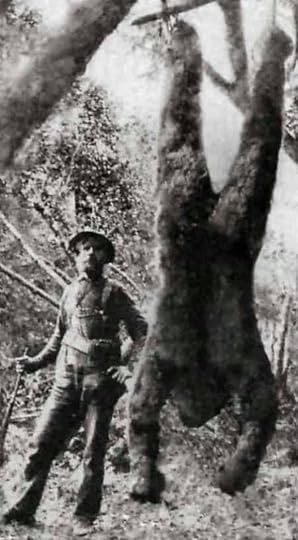 The infamous 'dead bigfoot photo' (origin unknown)
The infamous 'dead bigfoot photo' (origin unknown)On 21 November 2006, after having received it from a reader with the user name 'captiannemo', Craig Woolheater posted on Cryptomundo the very intriguing photograph opening this present ShukerNature blog article, and which has since become popularly referred to as the 'dead bigfoot photo', together with a request for any information available concerning it.
In view of its very striking, tantalising image, the photo attracted much interest, and was subsequently reposted twice by Loren Coleman on Cryptomundo (16 and 22 April 2009) with further requests for information. It has also been featured on many other websites. Yet although numerous opinions have been aired as to what it depicts (a shot bigfoot, bear, gorilla?) and whether or not it is authentic or photo-manipulated, no conclusive evidence as to its true nature has ever been obtained and presented - until now!
Earlier today, Facebook cryptozoological colleague Tony Nichol brought the following vintage picture postcard to my attention:
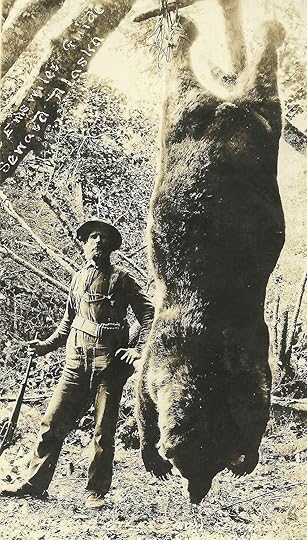 Vintage picture postcard depicting a hunter and shot Alaskan grizzly bear (purchased on ebay and now owned by Dr Karl Shuker – all rights reserved)
Vintage picture postcard depicting a hunter and shot Alaskan grizzly bear (purchased on ebay and now owned by Dr Karl Shuker – all rights reserved)With an example of it available for purchase on ebay's USA site, it depicted a shot grizzly bear, photographed in Seward, Alaska, and dating from the time period 1904-1918 - and as could instantly be seen, this was unquestionably the original image from which the bigfoot version had been created by photo-manipulation. After almost a decade, and as revealed here in this ShukerNature world-exclusive, the mystery of the 'dead bigfoot photo' is finally solved - except of course for discovering the identity of whoever created it from the vintage bear image.
To ensure that the latter does not become another 'missing thunderbird photo', however, I have actually now purchased the example of it available on ebay, and should be receiving it in the post shortly. Incidentally, the ebay wording present on the image of it contained in its ebay auction and shown above is naturally not on the actual postcard photograph itself, so once I have the postcard I'll include it in a more detailed documentation of the 'dead bigfoot photo' that I am currently preparing.
Perhaps I should also begin scanning ebay for the missing thunderbird photo ?!
Meanwhile, my sincere thanks go to Tony Nichol for kindly bringing the bear postcard to my attention, and, in so doing, enabling me to bring the lengthy reign of yet another cryptozoological pretender to its richly-deserved end.
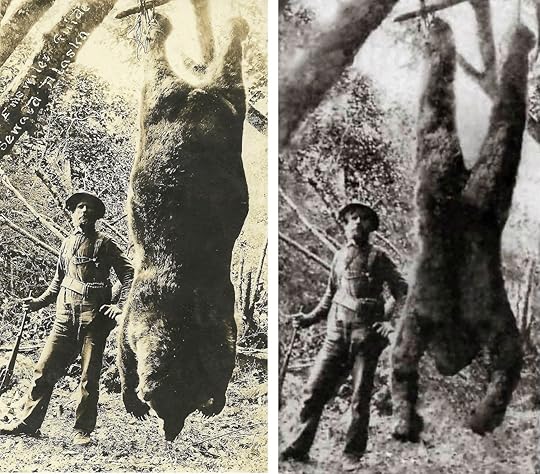 The original bear photograph alongside the derived, photo-manipulated 'dead bigfoot photo' (bear photo owned by Dr Karl Shuker – all rights reserved)
The original bear photograph alongside the derived, photo-manipulated 'dead bigfoot photo' (bear photo owned by Dr Karl Shuker – all rights reserved)
Published on April 11, 2015 13:01
April 3, 2015
FROM LAMBTON WORMS AND SHAGGY BEASTS TO SOUP DRAGONS AND Q – A DRACONTOLOGICAL TOP TEN ON SHUKERNATURE
 Official movie poster from the 1982 film Q – The Winged Serpent (© Larry Cohen (dir.)/United Film Distribution Company)
Official movie poster from the 1982 film Q – The Winged Serpent (© Larry Cohen (dir.)/United Film Distribution Company)As the author of two books on dragons – Dragons: A Natural History (1995) and Dragons in Zoology, Cryptozoology, and Culture (2013) – I've researched an extremely wide range of these reptilian monsters in my time. So here, excerpted from my two books, and in no particular order, are ten of my all-time favourite dragons and dragon-related subjects – a very diverse selection drawn from mythology, literature, and the media. And what more fitting, timely example with which to begin it than the Lambton worm, whose story supposedly began one Easter, long long ago…
THE LAMBTON WORM – AN ACCURSED BRITISH SERPENT DRAGON
The term 'dragon' is widely believed to derive from the Greek word 'derkein', which translates as 'sharp-eyed', and seems to have been applied originally to a snake. When transliterated into Latin, it became 'draco' – 'giant snake'. This is particularly apt because, morphologically, the basal dragon form was the serpent dragon. As its name suggests, in overall appearance this form, which was both limbless and wingless, resembled a huge snake or even a gigantic worm. Indeed, some serpent dragons were actually referred to as worms, also known as wyrms (an Old English term for snakes), wurms, or orms – all of which are terms derived from the Norse 'ormr' or 'ormer', translating as 'dragon'. Unlike these humble, harmless beasts, however, and betraying its draconian status, a serpent dragon had a head that was horned, long-jawed, and very often bearded.
Many of Britain's dragons were of the worm variety, which was also recorded widely across northwestern Europe. Dragon-headed and generally of immense length, worms not only lacked limbs and wings but also one of the characteristics most readily linked with dragons – the ability to breathe fire. However, this did not make them any less deadly – far from it. Instead of fire, worms emitted noxious clouds of poisonous gas that could lay waste to great swathes of countryside and decimate entire villages, or possessed a venomous bite of lethal propensity.
Worms could also kill by wrapping their huge coils around any potential antagonist, rather like real-life pythons and boas. They could even survive being chopped into several pieces, because the pieces swiftly reconnected with one another unless they were buried separately or burnt immediately.
Perhaps the most famous British worm is the Lambton worm, which reputedly grew from a small black leech-like beast caught in the River Wear, County Durham, on Easter Sunday 1420 by John Lambton - the youthful, impious heir to Lambton Castle, who had gone fishing while everyone else from the town of Washington close by attended church. Cursed for his blasphemy, Lambton sought redemption by journeying to the Holy Land on a pilgrimage after hurling his loathsome-looking catch into a nearby well. When he returned several years later, however, he was horrified to discover that the creature had grown into a monstrous worm that had been terrorising Washington's inhabitants by devouring their lifestock, wilting their crops with its toxic breath, and killing anyone who had dared to challenge it. Even chopping it in two had been futile – the two halves simply rejoined straight away.
Happily, however, Lambton was able to rid the town of this accursed creature. After seeking the advice of a wise witch, he commissioned the creation of an extraordinary suit of armour, bristling with long sharp spines. He then enticed the worm into the River Wear, and as soon as it attempted to crush him in its mighty coils, the spines on his armour sliced it into several segments, which were immediately carried away and dispersed by the river's fast-flowing current, so that they were unable to reconnect. Thus ended the Lambton worm's reign of terror.
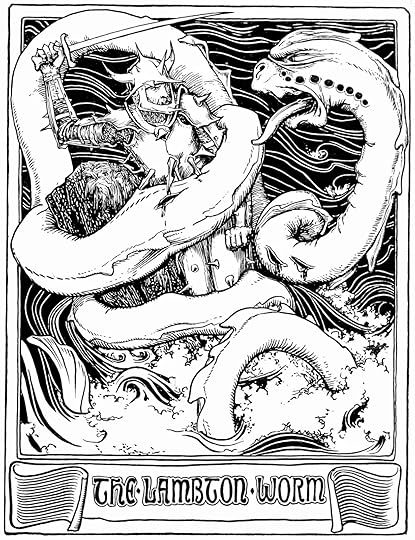 The Lambton worm, from an 1894 book of fairy tales (public domain)
The Lambton worm, from an 1894 book of fairy tales (public domain)This famous myth has been preserved through generations of retellings in northern England, but how it originated remains a mystery - unless, perhaps, the worm was in reality some less dramatic wild beast (or even an imaginative personification of a local now-forgotten natural disaster) that John Lambton had successfully combated? Having said that, however, eminent English historian and antiquarian Robert Surtees (1779-1834) claimed that during the early 19th Century he had seen at the village of Lambton (aka Old Lambton) in Washington a piece of preserved skin said to be from the Lambton worm, and which resembled the hide of a bull.
A similar ploy to Lambton's wearing of a spiny suit of armour was utilised in the killing of another British worm. This was when, during the 1300s, Sir William Wyvill wore a suit of armour covered in razor-sharp blades when battling an enormous worm at Slingsby in North Yorkshire. But this time, instead of a river dispersing the worm's body segments, the knight's faithful dog carried each segment away and buried it in a different location. Despite its resourcefulness, however, it could not save its master, or itself, from the worm's baneful effects. When it licked its grateful master's face, drops of the worm's deadly blood upon its jaws transferred inside its mouth and also onto the knight's face, and both man and dog died shortly afterwards.
THE HYDRA OF HERACLES AND THE HOAXED HYDRA OF HAMBURG
One of the most unusual, and deadly, dragons, of classical mythology was the Lernean hydra - whose slaying constituted one of the twelve great labours of the Greek hero Heracles (Hercules in Roman mythology).
Although this monster is usually depicted as wingless and only two-legged, it was more than ably compensated by virtue of its numerous heads (generally given as nine, but sometimes only seven, or as many as thirteen), each borne upon a separate neck. And each time that a head was cut off, two new ones grew in its stead, until Heracles successfully countered this by burning each neck as soon as its head was lopped off.
 Produced in 1921, John Singer Sargent's sumptuous rendition of Heracles battling a mighty 13-headed hydra (public domain)
Produced in 1921, John Singer Sargent's sumptuous rendition of Heracles battling a mighty 13-headed hydra (public domain)Even more marvellous in its own deceiving manner was the hoaxed hydra that was removed from a church in Prague in 1648 and subsequently owned by Johann Anderson, the Burgomaster of Hamburg. So spectacular was this preserved wonder that Anderson even rejected an offer of 30,000 thalers for it from Frederick IV, king of Denmark. In basic form, the hydra resembled a standard lindorm, sporting a long tail and sturdy scaled body but only two limbs and no wings. Instead of just a single neck and head, however, it boasted no less than seven of each, with all of the necks emerging from a common base.
Yet despite the hydra's extraordinary appearance, its perceived monetary value eventually decreased, until by 1735 negotiations had begun for its sale at a mere 2000 thalers. Before these could be completed, however, eminent naturalist Carl Linné (who subsequently Latinised his name to Linnaeus) examined this celebrated specimen, and exposed it as a fraud. The heads, jaws, and feet were those of weasels, and a series of snake skins had been pasted all over its body.
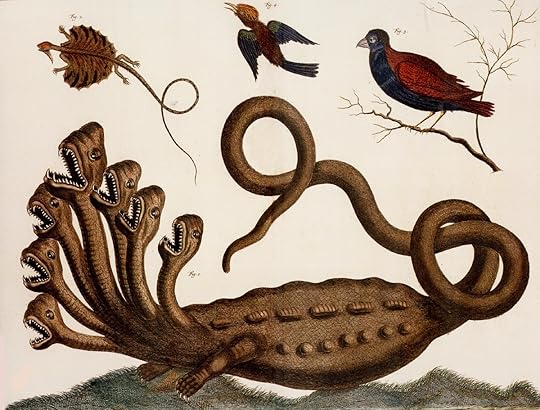 Depiction of the hoaxed hydra of Hamburgin Albertus Seba's Cabinet of Natural Curiosities (Vol. 1), 1734 (public domain)
Depiction of the hoaxed hydra of Hamburgin Albertus Seba's Cabinet of Natural Curiosities (Vol. 1), 1734 (public domain)Linnaeus speculated, however, that this exhibit had probably been created not by wily vendors to sell as a supposedly genuine hydra to some unwary buyer for an eye-watering sum of money, but rather by monks as a representation of the seven-headed dragon of the Apocalypse with which to chastise and terrify disbelievers. Yet whatever the reason, the result was outstanding, but even so, once this hoaxed hydra's true nature had been revealed by Linnaeus, the deal for its sale fell through, and shortly afterwards the hydra itself vanished – never to be seen again.
DRAGONS ON CHILDREN'S TELEVISION
There have been many notable small-screen dragons, but thanks to the charmed tenacity of nostalgia, perhaps those that we most readily recall are ones that featured in shows from our childhood.
One of the legendary names in British children's TV is Oliver Postgate (1925-2008), who created and wrote some of the most beloved shows of all time in this special genre of television – 'Bagpuss', 'Clangers', 'Noggin the Nog', 'Ivor the Engine', and 'Pogles' Wood', among others. They were all made by his company Smallfilms (founded with Peter Firman), and screened by the BBC. Some of these featured delightful dragons, remaining cherished childhood memories for generations.
Originally screened from 1969 to 1972 but repeated numerous times thereafter, 'Clangers' was a stop-motion show of 27 10-minute episodes. They featured a family of small whistling aliens, the clangers, with long snouts and knitted waistcoats. These share a tiny hollow planet with a host of exotic fauna and flora, such as the iron chicken, the froglets, the musical trees, and, most notable of all, the soup dragon. It is she who obtains from the planet's volcanic soup wells the delicious blue string pudding and green soup that the clangers adore. It was this character (and her baby dragon) who inspired the name of Scottish alternative rock band The Soup Dragons.
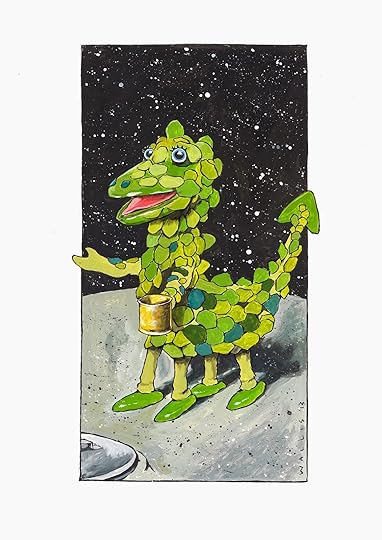 A delightful personal interpretation by fantasy artist Anthony Wallis of the soup dragon from 'Clangers' (© Anthony Wallis)
A delightful personal interpretation by fantasy artist Anthony Wallis of the soup dragon from 'Clangers' (© Anthony Wallis)Consisting of 27 10-minute episodes (six in colour) of limited stop-motion photography and first screened in 1959, 'Noggin the Nog' was a Norse-type saga about a tribe of Northmen, the Nogs, led by King Noggin, and featuring an extensive cast of characters. These include Noggin's villainous uncle Nogbad the Bad, inventor Olaf the Lofty, a giant green bird called Graculus, Arup the great walrus, and an amiable ice dragon known as Groliffe (not to mention a flying machine and a fire machine!). Befriended by Noggin, Groliffe subsequently comes to his aid when he and his friends are in trouble.
Spanning 1959 to 1977 and consisting of 32 10-minute black-and-white episodes and 40 5-minute colour episodes of stop-motion photography, 'Ivor the Engine' was famously set in "the top left-hand corner of Wales". It features a green locomotive called Ivor, his driver (Edwin) Jones the Steam, plus several supporting characters. Notable among them is Idris, a small red heraldic dragon based upon the emblem of Wales, who lives with his wife and two dragon children in an extinct volcano called Smoke Hill, and sings in the local choir.
A dragon called Dennis who combined the best of both geographical types appeared in 'James the Cat' – a cartoon series of 52 5-minute episodes screened by the BBC from 1984 to 1992. One of many animal friends of the show's title character, Dennis is a pink Chinese dragon but breathes fire and speaks with a Welsh accent!
A happiness-bringing luck dragon long before Falkor debuted in the novel and film versions of The Neverending Story, Chorlton was the friendly but somewhat slow-witted star of an enchanting British series entitled 'Chorlton and the Wheelies', originally screened on ITV from 1976 to 1979. In the very first of its 40 stop-motion animated episodes, created by the company Cosgrove Hall, Chorlton hatches from an egg and then arrives in Wheelie World. This is a strange land populated mostly by Wheelies – creatures that have wheels instead of legs, but which are burdened with sadness conjured up by a wicked witch called Fenella...until Chorlton's happiness soon dispels the gloom. In subsequent episodes, Fenella puts into practice all manner of evil schemes to rid Wheelie World of Chorlton, or cause problems for him, but he and his Wheelie friends invariably manage to foil them.
One of the most popular series from the golden age of children's TV in the USA was 'H.R. Pufnstuf', a live-action show featuring life-sized puppets whose 17 25-minute episodes were first screened from September 1969 to September 1971. H.R. Pufnstuf is not only a dragon but also a mayor – of a magical isle called Living Island. Here everything is alive, even the houses, and is where an 11-year-old boy called Jimmy (played by Jack Wilde, the artful dodger in the 1968 film musical Oliver!) and his talking flute Freddy are taken to in a mysterious boat. The series' basic scenario is similar to that of 'Chorlton and the Wheelies', in that the bane of Living Island is a troublesome witch, called Witchiepoo here, but her evil plans are always thwarted by the dragon, Jimmy, and their many friends there.
Originally aired in Canada and the USA from 1993 to 1997, and running to five seasons, collectively containing 65 30-minute episodes, 'The Adventures of Dudley the Dragon' was a live-action show in which a full-costumed actor played Dudley. Befriended by two children after waking up from centuries of hibernation, Dudley finds out what the modern-day world is like, with particular emphasis upon environmental issues.
Other popular children's TV shows featuring dragons included 'Wacky Races', 'My Little Pony', 'The Smurfs', 'Pocket Dragon Adventures', 'Eureeka's Castle', 'Digimon', and, for older children and teenagers, 'Power Rangers', 'Dungeons and Dragons', and several Manga series. Moreover, countless TV cartoons have featured dragons as one-off foes or comic relief characters.
 Not all dragons are huge and frightening, some are very small and very sweet, especially in children's media (© Thomas Finley)
Not all dragons are huge and frightening, some are very small and very sweet, especially in children's media (© Thomas Finley)THE PELUDA – SHAGGY SURVIVOR OF NOAH'S GREAT FLOOD
Even among the unparalleled diversity of dragon forms, the following example from traditional French folklore was truly unique and unforgettable.
There on the bank of the river Huisne, at La Fert‚-Bernard in medieval France, something was definitely moving. Suddenly, what appeared at first to be the head and sinuous body of a huge viper-like snake emerged from a spherical mass of bright green vegetation, and reared upwards above it. Moments later, however, the vegetation itself began to move, quivering as if it were a living creature - which was only to be expected, for that was precisely what it was. What had seemed to be nothing more than a cluster of riverside foliage was in reality the round body of a huge animal with shaggy green fur - and what had appeared to be a giant serpent was now exposed as this extraordinary animal's head and neck!
It was the peluda - a terrifying amphibious neo-dragon also known as the shaggy beast, which had been spawned in early biblical days and was refused entry onto Noah's Ark, yet had nonetheless survived the Great Flood, and was now terrorising the environs of La Fert‚-Bernard. Its dense green pelage partially hid four horny, turtle-like feet, and bristled with countless numbers of spine-like quills - which contained potent stinging venom, and could be jettisoned like poisonous javelins into anything unwary enough to approach too closely. This monstrous beast could also kill a person with a mighty thwack of its immensely powerful tail - and when it was sufficiently angered, a single blast of flame spewed forth from its coiled throat could incinerate fields for miles around.
 The peluda or shaggy beast (© Helena Zakrzewska-Rucinska/Dr Karl Shuker/MarshallEditions, from my book
Dragons: A Natural History
)
The peluda or shaggy beast (© Helena Zakrzewska-Rucinska/Dr Karl Shuker/MarshallEditions, from my book
Dragons: A Natural History
)For a time, the peluda had contented itself with raiding farms and stables each night in search of horses and other livestock as prey - robbing the farmers of their livelihood, but rarely of their lives, unless they were foolish enough to challenge its depredations.
Occasionally, massed attacks on the beast by brave companies drawn from the local populace had succeeded in driving it into the Huisne - but the peluda was of such colossal size that whenever it submerged itself underwater, the river immediately overflowed its banks, and much of the district bordering on either side was completely flooded, thereby causing as much devastation to the farmers as the monster's own onslaughts.
More recently, however, the situation had become even worse, for the peluda had lately expanded its dietary scope - adding children and damsels to its murderous menu. Several of the village's fairest maidens had been devoured, and only this morning yet another had been ambushed and carried away - but this time she had not been alone. Her valiant fianc‚ had been nearby, and had witnessed the terrible deed. Now he swore vengeance against her antediluvian attacker, and he took up his trusty sword to do battle.
Protected from the peluda's deadly arsenal of self-propelling quills by his suit of mail, and additionally armed with knowledge gained from the village's wisest seer, the bold youth strode forth and aimed a terrible blow with his sword - but not at the monster's undulating neck, and not even at the heaving belly concealed beneath its shaggy fur. Instead, he hacked down at its writhing tail, and severed it in two with a single slash of his keen blade. Instantly, the mighty peluda keeled over and died - for its tail was the only portion of its body vulnerable to mortal injury.
Back in La Fert‚-Bernard there was great rejoicing, and the remains of the peluda were embalmed. As for its conqueror, he was acclaimed forever more as a hero, and rightly so - after all, he had achieved a feat that not even the Great Flood had been able to accomplish!
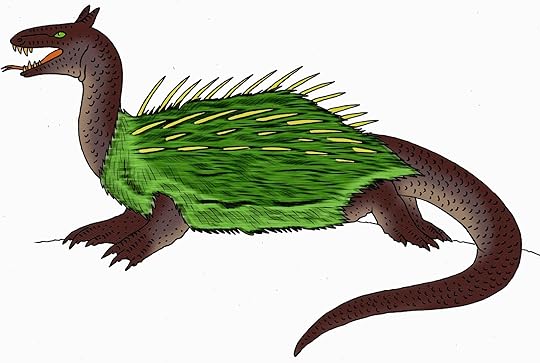 Another artistic representation of the peluda (© Tim Morris)
Another artistic representation of the peluda (© Tim Morris)THE PYRALLIS – A VERITABLE FIRE-FLY DRAGON!
The smallest of all dragons and entirely at home in the midst of a blazing fire was a tiny beast termed the pyrallis. Also called the pyragones or pyrausta, this remarkable animal was no bigger than a large fly, and resembled a four-legged insect, with burnished bronze body and golden filigree wings - but its head was that of a dragon.
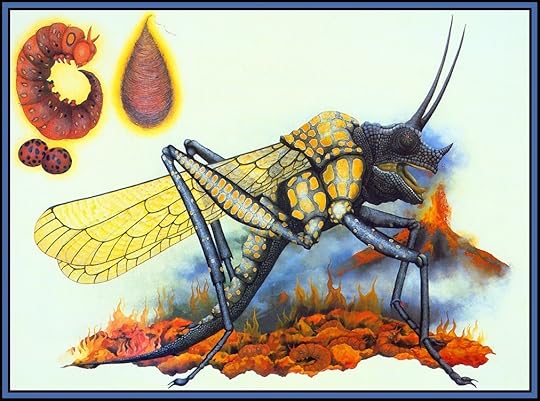 A pyrallis, as depicted by Una Woodroffe in her spectacular illustrated book Inventorum Natura (© Una Woodroffe/Paper Tiger)
A pyrallis, as depicted by Una Woodroffe in her spectacular illustrated book Inventorum Natura (© Una Woodroffe/Paper Tiger)It was associated exclusively with the copper smelting forges and foundries of Cyprus, in which swarms would dance and cavort like incandescent will-o'-the-wisps. Yet if one of these animate sparks should fly out of the flames, even for the briefest of instants, it would die at once - because the pyrallis drew not merely its sustenance but its very life-force from the furnaces' burning heat and raging vitality. Truly a beast of the fire and the flame!
DRAGONS OF MIDDLE-EARTH
Considered by many readers and literary critics alike as the most significant and influential modern-day works of fantasy fiction ever published, The Hobbit (1937), The Lord of the Rings trilogy (1954, 1954, 1955), The Silmarillion (1977), and J.R.R. Tolkien's other novels contain a number of important dragons.
It has often been supposed that his works are Christian allegories or are at least derived from Christian themes, and therefore comparable in terms of inspiration to the Narnia novels of C.S. Lewis. In reality, however, Tolkien's principal muse was the Elder Edda – a collection of Old Norse myths and legends preserved principally within the Codex Regius, which is a medieval Icelandic manuscript, written in the 13th Century. Yet the myths and legends themselves are far older, and include all of the famous Norse ones known today.
Many familiar character names in Tolkien's books, for example, including Gandalf and various of the dwarves featuring in The Hobbit, were borrowed directly by him from the Elder Edda. So too were other entities and themes, one of which that attracted his particular attention being the slaying by the hero Siegfried of the evil dwarf Fafnir, who had transformed himself into a typical Nordic dragon in order to protect his ill-gotten treasure hoard. This dragon became the basic template for the various examples featuring in Tolkien's novels.
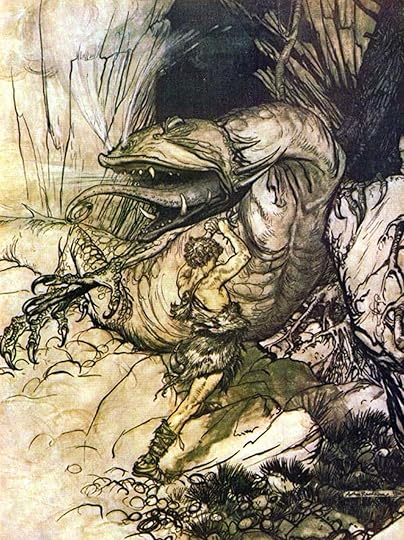 Siegfried slaying a dragon-transformed Fafnir in this stunning artwork by Arthur Rackham (public domain)
Siegfried slaying a dragon-transformed Fafnir in this stunning artwork by Arthur Rackham (public domain)Yet although Tolkien's dragons were of traditional Nordic form and treasure-hoarding behaviour, they were much more intelligent than their antecedents in the Old Norse myths and legends, and they could speak too.
Created by the dark lord Morgoth, there were three types – the great worms, the winged quadrupedal dragons, and the wingless quadrupedal dragons. Some could also breathe fire, enabling them to destroy the lands and cities of Middle-Earth's men, elves, and dwarves.
The first Middle-Earth dragon was Glaurung, a huge wingless fire-breather, which ultimately spawned numerous lesser dragons, and led them into battle on the side of Morgoth against the elves, but was finally slain by the hero-warrior Túrin.
The greatest Middle-Earth dragon of all, however, was Ancalagon the Black, the first winged fire-breather. His appearance alongside his spawn astonished the entire world, and initially gave victory to Morgoth's horde – until the great eagles and other warrior birds rallied against them, eventually achieving victory over their reptilian foes and breaking Morgoth's power forever. Ancalagon was slain by warrior Eärendil, and so enormous was this mighty dragon's body that when it plummeted down from the sky to earth, it decimated the three-peaked mountain Thangorodrim.
The last famous Middle-Earth dragon was Smaug, a huge golden-red winged monster almost entirely ensheathed in impermeable iron scales. Smaug destroyed with fire the human city of Dale and vanquished the dwarves from the Kingdom under the Mountain (of Erebor) in order to seize for himself their vast treasure of gold, jewels, and precious elvish metals stored there. This he jealously guarded for almost two centuries until disturbed by a party of dwarves seeking retribution, led by Thorin Oakenshield and also including among their number the hobbit Bilbo Baggins. It was Bilbo who discovered the one vulnerable region on Smaug's underside, which enabled a Northman archer named Bard the Bowman to slay Smaug after he had attacked the city of Esgaroth upon the Long Lake.
More light-hearted and whimsical was another Tolkien dragon – Chrysophylax Dives. Pompously comical but still wily and villainous, he was finally captured and controlled by Farmer Giles of Ham in the book of the same title, using a mighty sword called Caudimordax (aka Tailbiter) that once belonged to a famous dragon-slayer.
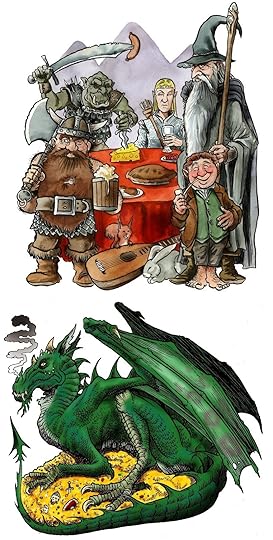 A classic collection of Tolkien characters (© Richard Svensson)
A classic collection of Tolkien characters (© Richard Svensson)THE LONGMA – SCALY DRAGON HORSE OF CHINA
One of the most unusual Oriental dragons was the longma or Chinese dragon horse. Traditionally deemed to be the vital spirit of Heaven and Earth, as indicated by its English name it was a curious yet surprisingly effective composite of two very different animals - sporting the body, legs, and hooves of a horse, but the head and scales of a dragon. Some, though not all, dragon horses also possessed a pair of wings, and could walk upon the surface of water without sinking.
Legend has it that eight winged dragon horses pulled the carriage of Emperor Mu of Jin (belonging to the Eastern Jin Dynasty) as he travelled around the world during the post-regency period of his reign (he reigned from 343 AD to 361 AD).
It was a yellow dragon horse that emerged long ago from the River Lo to reveal the eight trigrams of the famous divination system known as I Ching. Similarly, a dragon horse rose up out of the Yellow River and gave to the Emperor a circular diagram depicting the yin-yang.
 Wooden carving of a dragon horse (© Dr Karl Shuker)
Wooden carving of a dragon horse (© Dr Karl Shuker)According to the Imperial Readings of the Taiping Era (aka Taiping Yulan) – a massive 1000-volume, multi-contributor Chinese encyclopaedia dating from the 10thCentury – a dragon horse spotted blue and red, covered in scales, sporting a thick mane, and giving voice to a mellifluous flute-like neigh once appeared in the year 741 AD, which was taken to be a good omen for the reigning emperor, Xuanzong of Tang. So fleet-footed that it could cover more than 280 miles without a pause, this wonderful beast had been born to a normal mare that had become pregnant after drinking water from a river in which a dragon had bathed.
During the 7thCentury, the Turkestan city of Kucha (now part of China) was visited by the travelling Chinese Buddhist monk and scholar Hsuan-Tsang, who noticed that a lake in front of one of this city's temples contained a number of water dragons. He was informed that they could change their form so as to mate with mares, and that the progeny of this curious crossbreeding were dragon horses, of a fierce, wild nature, and very difficult to tame.
Q – A VERY QUIRKY MOVIE DRAGON
One of the quirkiest yet most original dragon-based films ever released, and one of my own particular favourites, is director Larry Cohen's 'Q – The Winged Serpent' (1982). In it, a cult in New York City successfully resurrect Quetzalcoatl, the ancient flying serpent deity of Aztec mythology, who proceeds to swoop down from Manhattan's skies and skyscrapers to seize, dismember, and devour unwary city dwellers.
In appearance, however, this odd-looking entity is not serpentine at all, instead resembling a rather gangly, long-necked quadrupedal dragon with wings. Yet its smooth skin seems devoid of typical reptilian scales or spines, and it does not sport any feathers either – despite the original Quetzalcoatl being a plumed sky serpent.
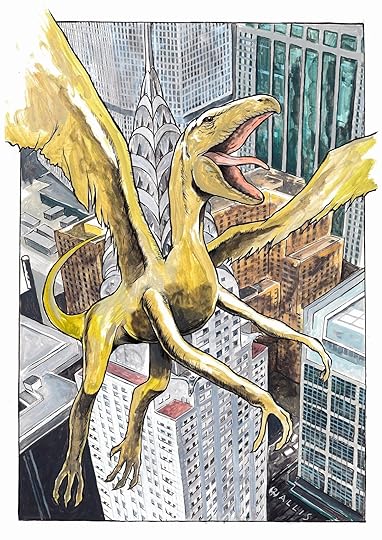 Fantasy artist Anthony Wallis's superb personal interpretation of Q – the Winged Serpent (© Anthony Wallis)
Fantasy artist Anthony Wallis's superb personal interpretation of Q – the Winged Serpent (© Anthony Wallis)Perhaps the epitome of the modern-day dragon film, however, is 'Reign of Fire' (2002), directed by Rob Bowman, and starring Christian Bale and Matthew McConaughey.
Set in the year 2020, this post-apocalyptic film reveals the devastation that has resulted after a sleeping dragon was inadvertently chanced upon and woken in an underground cave during some construction work on the London Underground shortly after the beginning of the new millennium. The dragon forced its way to the surface, swiftly multiplied, and within a dozen years humanity was virtually wiped out by a worldwide plague of flying fire-breathing dragons.
Finally, however, a brave survivor, Quinn Abercromby (played by Bale), and his isolated community hiding out in a Northumberland castle reluctantly join forces with a band of American fighters led by Denton Van Zan (McConaughey) to bring to a decisive end the dragons' literal reign of fire. Although the story's premise seemed decidedly far-fetched, the special effects were truly astonishing.
 A memorable 'Reign of Fire' dragon as personally interpreted by fantasy artist Anthony Wallis (© Anthony Wallis)
A memorable 'Reign of Fire' dragon as personally interpreted by fantasy artist Anthony Wallis (© Anthony Wallis)A COLLECTION OF PRESERVED 'CROCODILE DRAGONS'
There are a number of so-called 'preserved dragons' in existence around the world, but when examined some of these physical specimens have been readily exposed as being of crocodilian identity. Perhaps the most notable example is the 'Brno lindworm' (wingless four-legged classical dragon), of Moravia in the Czech Republic, which since at least 1608 AD has been hanging suspended from the ceiling of the arched passage leading to the city's town hall, and can still be seen here today. To protect it from the weather, it has been liberally covered in black pitch, but its identity as a crocodile – albeit a very sizeable one, as it measures approximately 15.5 ft long - remains instantly apparent.
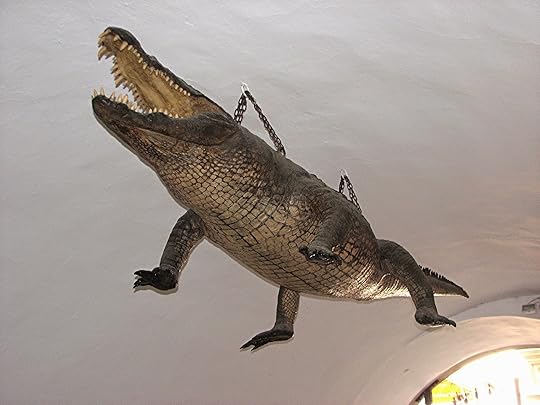 The preserved Brno'lindworm' dragon (© Miroslav Fišmeister)
The preserved Brno'lindworm' dragon (© Miroslav Fišmeister)According to traditional Moravian folklore, this is the dragon that long ago was said to have slaughtered livestock and even young children in a prolonged assault on Brno (then called Brünn), until it was duped into feeding upon a freshly-killed calf's skin that had been cunningly filled with unslaked lime. After eating it, the dragon was consumed with such a fiery thirst that it drank without pause from a nearby stream until finally the lime reacting with the vast quantity of imbibed water caused the doomed dragon to explode.
The same fate befell Smok, the dragon of Wawel Hill in Krakow, Poland, which had terrorised the city until Skuba, a canny cobbler's apprentice, stuffed a baited lamb with sulphur. Incidentally, in 2011 a very large species of Polish carnivorous reptile from the late Triassic Period 205-200 million years that may constitute a species of theropod dinosaur was officially christened Smok wawelski, in honour of this Polish dragon.
Souvenir ornament portraying Smok (© Dr Karl Shuker)
Another crocodilian dragon once hung from the roof of the cathedral of Abbeville in Picardy, France. And until at least as recently as the early 1850s, what was either a stuffed 6-ft-long crocodile or lizard (monitor?) could be seen suspended in the church of St Maria delle Grazie, near Mantua, in Italy. Local lore claims that it had been killed in some adjacent swamps in c.1406. More likely is that all of these specimens had been brought back to Europe as unusual souvenirs by returning travellers or crusaders, or even as exotic living specimens for private collections or sideshows.
DRAGON TATTOOS
Body art has experienced an enormous resurgence in recent years, especially tattoos and tattooing, and one of the most fashionable, in-demand subjects for a tattoo is the dragon. Indeed, there is even a much-sought-after book devoted entirely to dragon tattoos – Donald Ed Hardy's lavishly-illustrated tome Dragon Tattoo Design (1988), containing countless designs for every taste in dragons.
Whether in the West or the East, most tattooed dragons are of the Oriental category (though the red Welsh dragon is popular as a symbol of Celtic patriotism). Its slender, serpentine form and rich spectrum of vivid colours allows itself to be readily applied to a person's back, arms, chest, or legs, and to achieve individuality for them. Several notable celebrities sport dragon tattoos, including singers Lenny Kravitz, Pink, and Mels B and C of the Spice Girls, as well as actor Bruce Willis, and actress Angelina Jolie.
There is a plethora of symbolism associated with dragon tattoos, depending in particular upon their type, colour, activity, the presence of other animals alongside them, and the sex of the person selecting them.
Oriental dragons in general are associated with freedom, protection, and nobility, but in keeping with their status and role in traditional mythology, the tattoo of a Chinese dragon more specifically symbolises good fortune and wisdom, whereas the more elongate, fewer-clawed Japanese dragon personifies balance in life. As already noted, the Celtic dragon symbolises pride in one's Celtic ancestry but also power and strength, and is sometimes depicted alongside a crown or even a throne. Other Western dragons, which are particularly popular when portrayed as stylised tribal tattoos, also represent bravery, ferocity, and even war-like attributes - hearkening back to their traditionally darker, less benign image than that of their Oriental counterparts.
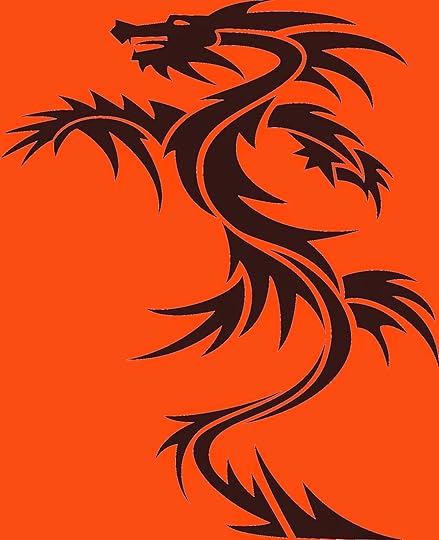 A Western dragon in a tribal tattoo design (public domain)
A Western dragon in a tribal tattoo design (public domain)A tattoo of a yellow Oriental dragon symbolises knowledge, helpfulness, and a good companion, as does one of a gold Oriental dragon (which is also utilised to indicate a kind personality), whereas a green one embodies life and the planet, a red one symbolises keen eyesight, and a black one shows that its bearer has old but wise parents. A blue dragon tattoo is associated with compassion and forgiveness. But beware: in Chinese tradition, blue dragons also symbolise sloth and idleness - so make sure that you don’t give out the wrong impression if you choose this symbol as a tattoo!
A tattoo depicting an Oriental dragon protecting treasure signifies wealth (either material or spiritual). A coiled dragon personifies the oceans but also suggests that, just like those vast bodies of water, the person bearing this tattoo has hidden, mysterious depths to their personality, and a horned dragon represents strength and authority in both deed and intent, because only the more advanced Oriental dragons possess horns. If the fuku-riu type of Japanese dragon is chosen for a tattoo, its bearer is hoping to attract good fortune, as this type is traditionally the luck dragon in Japan.
Oriental dragons are still revered as rain and water deities, so if such a dragon is tattooed reposing near to water, i.e. its normal resting state, this symbolises tranquillity and peace of mind. However, if the dragon's teeth show, or, if winged, its wings are extended, this can denote hostility or aggression. Taking great care and giving thought beforehand when selecting a dragon tattoo is very important, therefore, to avoid its sending out an inappropriate or unwanted message, especially as tattoos cannot be easily removed or amended once applied.
 My own tattoo of a serpent dragon entwined around a dagger, symbolising strength, which was tattooed on me by Birmingham-based tattoo artist and good friend Gary Stanley, aka Stigmata (© Dr Karl Shuker)
My own tattoo of a serpent dragon entwined around a dagger, symbolising strength, which was tattooed on me by Birmingham-based tattoo artist and good friend Gary Stanley, aka Stigmata (© Dr Karl Shuker)Dragon tattoos on men typify the general dragon-allied symbolism of power, wisdom, courage, and protection, and are often applied to readily-visible regions of the body like arms or legs (often as full-sleeve tattoos), across the shoulders or chest, or encompassing the back. When present on women, conversely, they tend to appear on less overt regions, such as feet, ankles, nape, near the navel, or down the sides, and are more closely linked with creation, emphasising that it is women who give birth. Consequently, mothers (especially new ones) often select a dragon when choosing a tattoo.
Sometimes an Oriental dragon and Chinese phoenix are tattooed together, forming a circle or otherwise intimately linked with one another, which symbolises a successful marriage. Tigers in ancient Oriental tradition often represent aggression and evil intent, so a dragon tattooed above a tiger indicates that its bearer has overcome darkness in their life, or intends always to do so. Avoid tattoos of dragons battling with tigers if tattoo symbolism is important to you, however, because these images can indicate aggression or internal conflict.
An attractive way of enhancing both the physical appearance and the symbolic significance of a dragon tattoo is to add a message alongside it, written in either Chinese Hanji or Japanese Kanji script.
Above all, a dragon tattoo signifies that the bearer is special. If there could be just a single tattoo to personify the phrase "Why be ordinary when you can be extraordinary?", it would be a dragon.
The continuing popularity of dragons in every conceivable facet of our culture confirms that even though we may no longer believe in them, we certainly cannot forget them! Indeed, it is evident that the dragon will continue to evolve, diversify, and populate our planet for a very long time to come. The dragon is dead - long live the dragon!
 And here's one I slew earlier! (© Dr Karl Shuker)
And here's one I slew earlier! (© Dr Karl Shuker)This ShukerNature article is excerpted from my books Dragons: A Natural History and Dragons in Zoology, Cryptozoology, and Culture – check them both out for vast amounts of addition dracontological data!

Published on April 03, 2015 17:13
April 1, 2015
'IF ONLY...' - IN MEMORY OF MY MOTHER, MARY SHUKER (1921-2013)
 (Above and below) Mom and I at Hong Kong's Cat Street Markets/Galleries, summer 2005 (© Dr Karl Shuker)
(Above and below) Mom and I at Hong Kong's Cat Street Markets/Galleries, summer 2005 (© Dr Karl Shuker)Please click: Star Steeds and Other Dreams: IF ONLY...

Published on April 01, 2015 16:38
March 18, 2015
BOTHERSOME BEITHIRS AND OTHER FRESHWATER MYSTERY EELS?
 Delightful depiction of Nessie as a giant eel (© Richard Pullen)
Delightful depiction of Nessie as a giant eel (© Richard Pullen)I have already discussed on ShukerNature the prospect that certain serpentiform sea monsters might be still-undiscovered giant marine eels – Dr Bernard Heuvelmans's 'super-eel' category of sea serpent (click here ). Similarly, a number of freshwater mystery beasts reported from Britain and elsewhere in the world may also conceivably be unusually large eels - a thought-provoking possibility previously visited on ShukerNature in relation to reports from ancient times of supposed giant blue eels inhabiting India's Ganges River (click here ), and now revisited in the following selection of additional eye-opening examples.
NEVER BOTH A BEITHIR
The Loch Ness monster (LNM) may well be Scotland's best known freshwater mystery beast, but it is not this country's only one. Far less familiar yet no less intriguing in its own way is the beithir. In 1994, a correspondent to the English magazine Athenepublished two fascinating articles containing various modern-day beithir sightings. During early 1975, he encountered a fisherman near Inverness who claimed that he and four others once sighted a beithir lying coiled in shallow water close to the edge of a deep gorge upstream of the Falls of Kilmorack. When it realised that it had been observed, however, it thrashed wildly about before finally swimming up the gorge near Beaufort Castle and disappearing. The fishermen estimated its length at around 10 ft.
Four months later, the Athene correspondent learnt of another sighting, this time offshore of Eilean Aigas, an island in the River Beauly, Highland. He was also informed by a keeper at Strathmore that during the 1930s his wife's parents had seen beithirs moving overland at Loch a' Mhuillidh, near Glen Strathfarrar and the mountain of Sgurr na Lapaich. After discussing these reports with various zoological colleagues, he considered that the beithir was probably an extra-large variety of eel – fishes that are well known for their ability to leave the water and move overland to forage when circumstances necessitate, and even to sustain themselves out of water for protracted periods.
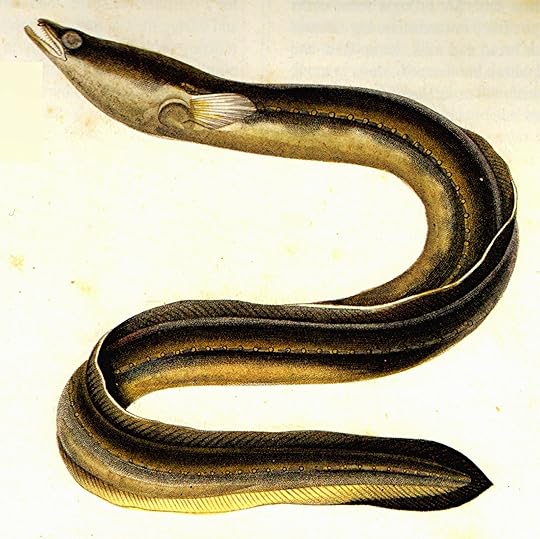 The European eel, painting from 1837 (public domain)
The European eel, painting from 1837 (public domain)Indeed, the Athene correspondent was informed by a Devon farmer that during the extremely harsh winter of 1947, his mother had been badly frightened to discover a number of eels alive and well in the farm's hayloft, where they had evidently been sheltering since the freezing over of the nearby river some time earlier. The rest of the family came to see this wonder, including the farmer himself (then still a boy), and his father confirmed that they were indeed eels, and not snakes (as his mother had initially assumed).
IS NESSIE A EUNUCH EEL?
The LNM (always assuming that it actually exists, of course!) has been labelled as many things by many people – a surviving plesiosaur, an unknown species of long-necked seal, and a wayward sturgeon being among the most popular identities proffered over the years. However, some eyewitnesses and zoological authorities – notably the late Dr Maurice Burton – have favoured a giant eel, possibly up to 30 ft long.
Under normal circumstances, the common or European eel Anguilla anguilladoes not exceed 5 ft, and even the conger eel Conger conger (one of the world's largest eel species, rivalled only by certain moray eels) rarely exceeds 10 ft. However, ichthyological researchers have revealed that growth in eels is more rapid in confined bodies of water (such as a loch), in water that is not subjected to seasonal temperature changes (a condition met with in the deeper portions of a deep lake, like Loch Ness), and is not uniform (some specimens grow much faster than others belonging to the same species).
Collectively, therefore, these factors support the possibility that abnormally large eels do indeed exist in Loch Ness. Moreover, sightings of such fishes have been claimed by divers here. Also of significance is the fact that eels will sometimes swim on their side at or near the water surface, yielding the familiar humped profile described by Nessie eyewitnesses. And a 18-30-ft-long eel could certainly produce the sizeable wakes and other water disturbances often reported for this most famous – and infamous – of all aquatic monsters.
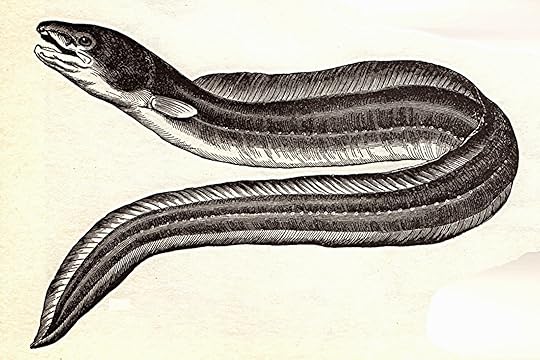 The conger eel (public domain)
The conger eel (public domain)Consequently, I would not be at all surprised if the presence of extra-large eels in Loch Ness is conclusively demonstrated one day. However, I cannot reconcile any kind of eel with the oft-reported vertical head-and-neck (aka 'periscope') category of LNM sightings, nor with the land LNM sightings that have described a clearly-visible four-limbed, long-necked, long-tailed animal.
Yet regardless of what creature these latter observations feature (assuming once again their validity), there is no reason why Loch Ness should not contain some extra-large eels too. After all, any loch that can boast a volume of roughly 1.8 cubic miles must surely have sufficient room for more than one type of monster!
In recent years, the giant eel identity for Nessie has been modified by some cryptozoological researchers to yield a creature as remarkable in itself as any bona fide monster – namely, a giant eunuch eel. It has been suggested that Nessie may be a gigantic, sterile or eunuch specimen of the common eel – one that did not swim out to sea and spawn but instead stayed in the loch, grew exceptionally long (25-30 ft), lived to a much greater age than normal, and was rendered sterile by some currently-undetermined factor present in this and other deep, cold, northern lakes.
This is undeniably a fascinating, thought-provoking theory, but Dr Scott McNaught, Professor of Lake Biology at Central Michigan University, has stated that even if such eels did arise, they would tend to grow thicker rather than longer. Nevertheless, giant eels remain a distinct possibility in relation to some of the world’s more serpentiform lake monsters on record.
MONSTER EELS IN THE MASCARENES
The concept of giant freshwater eels is by no means limited to Britain. For example: a number of deep pools in the Mascarene island of Réunion, near Mauritius, in the Indian Ocean, are supposedly inhabited by gigantic landlocked eels.
In a letter to The Field magazine, published on 10 February 1934, Courtenay Bennett recalled seeing during the 1890s when Consul at Réunion a dead specimen that had been caught in one such pool, the Mare à Poule d'Eaux, which is said to be very deep in places. It was so immense that "steaks as thick as a man's thighs were cut" from its flesh.
 Mare à Poule d'Eaux (©
http://www.chat-reunion.com
)
Mare à Poule d'Eaux (©
http://www.chat-reunion.com
)According to native testimony, moreover, during the heavy winter rains the giant eels could apparently be seen circling along the sides of this lake, searching for a way out. Being so exposed, however, they were prime targets for local hunters, who would catch them using a harpoon and a rope hitched round a tree. Their flesh would then be sold for food in a neighbouring village.
EXTRA-LARGE EELS IN JAPAN?
Several of Japan's biggest lakes are associated with accounts of freshwater eels reputedly much larger than typical specimens on record from these localities. A concise coverage of such creatures appeared in a detailed article concerning Japanese giant mystery fishes that was written by Brent Swancer and posted on 30 April 2014 to the Mysterious Universe website (click here to access the full article) and reads as follows:
Various locations in Japan have had reports of huge eels far larger than any known native species.
Workers doing construction on a floodgate on the Edo river reported coming across enormous eels measuring 2 meters (6.6 feet) long. According to the account, four of the eels were spotted and some of the workers even attempted to capture one, as the eels appeared to be rather lethargic and slow moving. They were unsuccessful as they did not have the equipment to properly catch one. Upon returning to the scene later on with the tools they needed, they found that the mysterious giant eels were nowhere to be seen.
Another account comes from Lake Biwa, which is in Shiga Prefecture, and is the largest freshwater lake in Japan. In the 1980s, there were several reports of giant eels inhabiting the lake.
One such sighting was made by a large group of people aboard one of the lakes many pleasure boats. Startled ferry passengers reported seeing several very large eels swimming at the surface far from shore. The eels were described as being around 3 meters (around 10 feet) long, and a silvery blue color. The eels appeared to be leisurely gliding along beside the boat and were observed for around 15 minutes before moving off out of sight.
A fisherman on the same lake reported actually hooking and reeling in an eel that was reported to be around 8 feet in length. In this case, the eel was kept and eaten. Another fisherman on the lake reported seeing a similarly sized eel rooting through mud in shallow water near the shore.
 Japan's Lake Biwa, as seen from Higashiamagoidake (public domain)
Japan's Lake Biwa, as seen from Higashiamagoidake (public domain)Interestingly, the giant blue eels of Lake Biwa readily recall comparably-described mystery beasts from India's Ganges River as reported by several early chroniclers (click here for my earlier-mentioned ShukerNature coverage of these latter cryptids).
GIANT EELS IN OHIO?
Although giant eels are a popular identity for water monsters, of both the marine and freshwater variety, because the size of eels is notoriously difficult to gauge accurately in the wild due to their sinuous movements and usual lack of background scale for precise length estimation this means that eyewitness reports of giant specimens are normally difficult to take seriously – which is why the following account is so significant. On 3 February 2015, Facebook friend Chris R. Richards from Covington, Washington State, USA, posted on the page of the Facebook group Cryptozoology the following hitherto-unpublished report of a huge freshwater eel that he and his father had personally witnessed during the 1990s:
I believe whole heartily in giant eels. I saw one as long as my canoe back in the later nineties. They could result in sea monster claims. Hocking River Ohio. Directly off the side of the canoe in clear water near upper part of river. At first thought it was a tree with algae in water, then saw the head and realized the "algae" was actually a frill. The animal was thicker than my arm. The head was at the front of the 15ft Coleman canoe and the tail end trailed behind my back seat. At the time this was amazing to both my father and I. Only later did I come to fully appreciate how amazing this sighting was. I got to see it the longest as we slowly passed it and I was in the back of the boat. [The eel was] 12 to 15 ft.
The frill was presumably the eel's long, low dorsal fin, which runs along almost the entire length of the body in freshwater anguillid (true) eels. What makes this report so exciting is that there is an unambiguous scale present in it – the known length of the canoe, alongside which the eel was aligned, thereby making its total length very easy to ascertain.
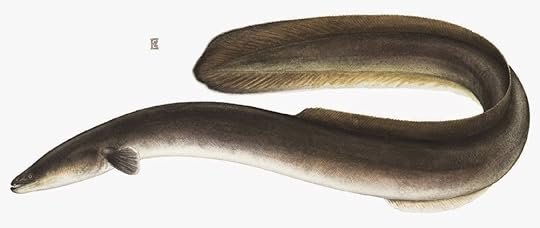 American eel (public domain)
American eel (public domain)The only such species recorded from Ohio is the common American eel Anguilla rostrata, which officially grows up to 4 ft long. Consequently, judging from the scale provided by the canoe, the eel seen by Chris and his father was 3-4 times longer than this species' official maximum size.
Assuming their report to be genuine (and I'm not aware of any reason to doubt it), there seems little option but to assume, therefore, that bona fide giant freshwater eels do indeed exist, at least in the Ohio waterways, which is a remarkable situation and clearly of notable cryptozoological interest.
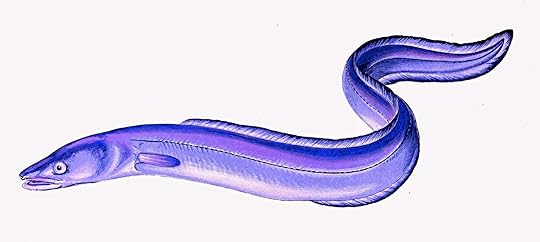 Reconstruction of the possible appearance of the Ganges giant blue mystery eel (© Dr Karl Shuker)
Reconstruction of the possible appearance of the Ganges giant blue mystery eel (© Dr Karl Shuker)
Published on March 18, 2015 20:15
March 8, 2015
THE CAMP FIRCOM CADDY CARCASE - MONSTER OR MONTAGE? - REVIEWING A LITTLE-KNOWN SEA SERPENT CONTROVERSY
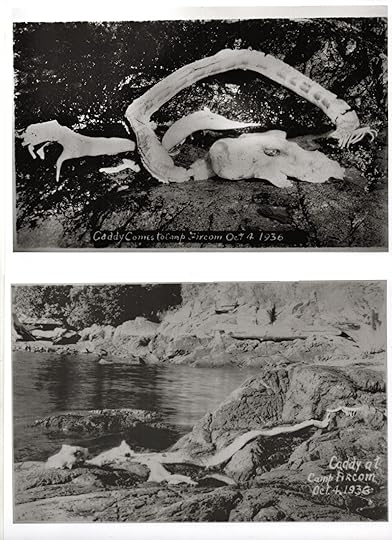 The two picture postcards (#1 top, #2 bottom) depicting the Camp Fircom Caddy carcase (public domain/FPL)
The two picture postcards (#1 top, #2 bottom) depicting the Camp Fircom Caddy carcase (public domain/FPL)Few cryptozoologists will be unaware of the Naden Harbour carcase – an enigmatic serpentine animal carcase measuring 10-12 ft long, sporting what looked like a camel-like head, long neck, pectoral flippers or fins, a very elongate body, and a fringed tail-like section that may have been a pair of hind limbs and/or a bona fide tail. It had been removed from the stomach of a sperm whale by flensing (blubber-removing) workers in a whaling station at Naden Harbour in Canada's Queen Charlotte Islands one day in early July 1937, and had then been placed by them on a long table draped with a white cloth and photographed.
Tragically, the carcase is apparently long-vanished, presumably discarded, but three photographs of it remain, and portray a creature that is sufficiently strange in appearance to have incited considerable controversy ever since as to its possible identity. Almost exactly 20 years ago and based upon the surviving photographic evidence, Dr Ed L. Bousfield, currently a Research Associate at Toronto's Royal Ontario Museum, and Prof. Paul H. LeBlond, now retired from the Department of Oceanography at the University of British Columbia in Vancouver, designated the Naden Harbour carcase (believed to be of a juvenile individual) as the type specimen of the longstanding serpentiform mystery beast informally known as Caddy or Cadborosaurus, the Cadboro Bay sea serpent, frequently reported off the northern Pacific coast of Canada and the U.S.A. In a paper constituting a supplement to the inaugural volume of the scientific journal Amphipacifica, published on 20 April 1995, based upon this specimen's morphology as seen in the photos they proposed that Caddy was a living, modern-day species of plesiosaur and they formally named its species Cadborosaurus willsi.
 The Naden Harbour carcase - a juvenile Caddy specimen? (G.V. Boorman/public domain)
The Naden Harbour carcase - a juvenile Caddy specimen? (G.V. Boorman/public domain)Far less familiar than the Naden Harbour carcase photographs, conversely, are two Caddy-linked pictures that were first brought to my notice 20 years ago. To my knowledge, they had never previously received any cryptozoological attention, and even today they remain little-publicised. Consequently, this present ShukerNature article reviews for the very first time the history and most notable opinions that have been offered to date in relation to the tantalising object(s) that these pictures depict.
Back in the mid-1990s, I was writing the text to my forthcoming book, The Unexplained: An Illustrated Guide to the World's Natural and Paranormal Mysteries , and Janet Bord of the Fortean Picture Library was supplying me with a number of illustrations for possible inclusion within it.
 My book
The Unexplained
(1996) © Dr Karl Shuker)
My book
The Unexplained
(1996) © Dr Karl Shuker)Unfortunately, she was not able to supply me with any of the Naden Harbour images as these had not been placed with the FPL and there was some degree of uncertainty concerning who owned their copyright at that time (they are now in the public domain). So although I did document it in my book, I couldn't illustrate my coverage with one of the pictures of it. Nevertheless, Janet was able to find a couple of old picture postcards depicting an alleged Caddy carcase washed up at Camp Fircom in British Columbia, Canada, on 4 October 1936 (less than a year before the Naden Harbour carcase was retrieved), and which I had never seen before. Janet did not have any details concerning these pictures on file other than the handwritten captions that were already printed upon them, and I was unable to uncover any mention of them in any of the sources of Caddy information available to me. (As for the actual postcards themselves, I assume from their style and the rather primitive quality of their photographs that they were originally on sale in the Camp Fircom area not long after the carcase had originally been discovered there.)
Frustratingly, moreover, the deadlines for writing and submitting to the publishers each section of the book's text meant that by the time that I'd received these interesting images, I'd already written and submitted my full quota of allotted text for my book's Caddy entry, so I couldn't have documented them there anyway. All that I could do, and which is precisely what I did do, was include the more detailed of the two images (Picture Postcard #1), tagged with the following informative caption: "Postcard depicting an unusual marine carcase, possibly a Caddy, that was found on the beach at Camp Fircom, British Columbia, on 4 October 1936".
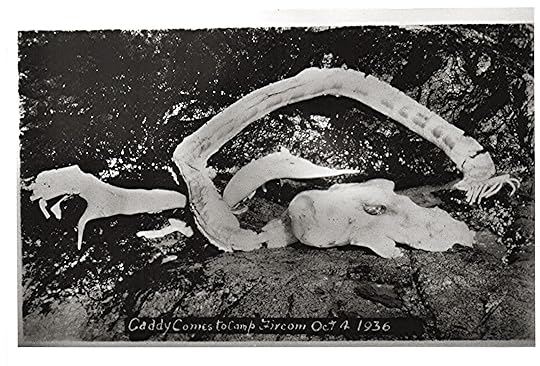 The Camp Fircom Caddy carcase, Picture Postcard #1 (public domain/FPL)
The Camp Fircom Caddy carcase, Picture Postcard #1 (public domain/FPL)In truth, however, the more that I looked at these pictures, especially the close-up view afforded by Picture #1, the more confused I became about what precisely I was looking at, because they certainly didn't resemble the more traditional supposed sea serpent carcases that wash up from time to time and invariably prove to be the highly decomposed, distorted remains of sharks, whales, or oarfishes. Indeed, by the time that my book was published in 1996, I considered it likely that they showed nothing more than a collection of sea-divulged debris, which may or may not have been artfully arranged by person(s) unknown to look monstrous in every sense, and thence cash in (possibly literally, via the sale of the picture postcards depicting this deceiving creation?) on the tradition of sea monster sightings in this part of the world. Nevertheless, I was pleased to have been able to include at least one of these puzzling pictures in my book, just in case it elicited any responses from readers supplying additional information or opinions relating to it. And sure enough, this is precisely what happened.
During the second week of February 1997, I received a detailed report from a then-university zoology student of Southampton, England, documenting his opinion as to what Picture #1 actually showed. That student is now palaeontologist Dr Darren Naish, who, like me, has long been interested in cryptozoological subjects in addition to mainstream zoology. Having viewed the photo at length in my book, Darren reported that although there were certain superficial similarities to the Naden Harbour carcase (large skull-like object with an apparent eye socket, long thin elongate body with a pair of anterior lateral projections sited where pectoral fins might be expected to be), he considered it to be a hoax – consisting of a montage of objects that he suspected had been deliberately chosen and arranged to give the impression of a carcase. The supposed skull, he felt, did not actually possess any definite skull characters, and, tellingly, its eye socket, placed in just the right location to resemble a true eye socket was, in Darren's view, the shell of a mussel. As for the long elongate body, he considered this to be the stem of a large plant, probably kelp, with finger-like projections at its distal or 'tail' end resembling the root-like holdfasts that anchor kelp to rocks. In short, a collection of marine/beach detritus deliberately positioned to look like a serpentiform monster carcase, thus echoing my own view regarding this.
Mindful that he hadn't seen Picture #2, I sent Darren a photocopy of it, which he briefly referred to (and he also included sketches of both pictures) within an expanded, illustrated version of the original report that he had previously sent to me, which was published in the summer 1997 issue of The Cryptozoology Review, now defunct. In it, he reaffirmed his opinion that the carcase was a composite of kelp, mussel shell, and beach rocks. Interestingly, although I could see why he thought that the eye socket in Picture #1's depiction of the skull-like object was a mussel shell, in Picture #2 it seems to me to be a genuine socket, i.e. a hole, because when this picture is enlarged I am sure that the seawater behind the skull-like object can actually be seen through the socket. That aside, however, I definitely concur and reaffirm that the Camp Fircom Caddy may be monstrous in form but is merely a montage in nature.
 The Camp Fircom Caddy carcase, Picture Postcard #2 (public domain/FPL)
The Camp Fircom Caddy carcase, Picture Postcard #2 (public domain/FPL)Even so, are the main components of it truly botanical rather than zoological in identity?
At much the same time that I was corresponding with Darren regarding these two pictures, I was also awaiting a response from Prof. LeBlond, to whom I had sent photocopies of the pictures, enquiring his opinion as to what they may portray.
In his letter of reply, dated 3 March 1997, Prof. LeBlond noted that he had seen: "…pictures of a lot of Caddy-like carcasses which have usually turned out to be sharks. Most of them look a lot like the Camp Fircom picture". Of particular interest was his comment:
What makes me think that the Camp Fircom carcass is yet another shark is the uniform roundness of the vertebrae, especially as seen in the upper picture [Picture #1]. The Neah Bay shark bones looked a lot like that: a "log" made of a series of cylindrical vertebrae, without extensions or projections.
Shark remains are sometimes found washed ashore at Neah Bayand elsewhere along the Pacific U.S. state of Washington's coast, and needless to say there are many cases on file (from North America and elsewhere around the world) of such remains being mistaken by eyewitnesses for sea serpent carcases.
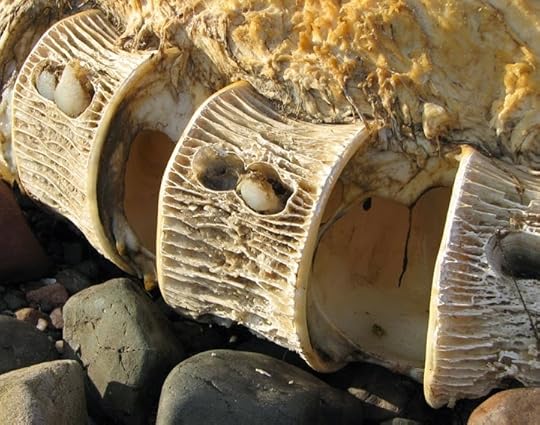 Basking shark vertebrae (© www.mylargs.comnaturemonstermonster2.shtml)
Basking shark vertebrae (© www.mylargs.comnaturemonstermonster2.shtml)Paul also stated that he had forwarded the photocopied pictures to Dr Bousfield, who very kindly wrote to me on 27 August 1997 with his own comments regarding them:
I tend to agree with Paul that the Camp Fircom carcase is very probably that of a basking shark. Local beach carcasses that have been attributed to "Caddy"-like animals appear similar to the remains of your photograph. Virtually all such remains, reported (with photographs) during the past 70+ years, have proven to be those of the large pelagic shark species common in surface waters of the North American Pacific coastal marine region.
The only photographs considered by us as reliably that of a "Caddy" carcass, are three fairly good images, taken from three different camera angles by two different photographers, at the Naden Harbour whaling station in 1937, and now deposited in the B.C. Provincial Archives here in Victoria.
Two of the three Naden Harbour carcase photographs are included in their book Cadborosaurus: Survivor From the Deep, published during the same year, 1995, as their more formal Amphipacifica paper.
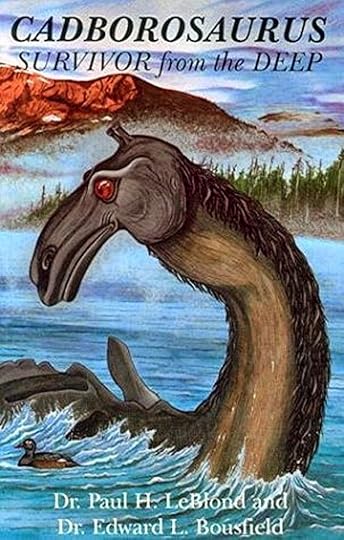 Cadborosaurus: Survivor From the Deep
(1995)(© LeBlond & Bousfield/Horsdal & Schubart)
Cadborosaurus: Survivor From the Deep
(1995)(© LeBlond & Bousfield/Horsdal & Schubart)So might the Camp Fircom Caddy carcase be a highly-decomposed shark, or at least include some shark-derived components within a heterogeneous array of objects?
For a long time, this enigmatic entity attracted little if any additional attention other than its two pictures featuring in a handful of East European cryptozoological websites but with no attendant comments concerning them. In a guest article regarding the Naden Harbour carcase that appeared in Jay Cooney's Bizarre Zoology blog on 17 June 2013, however, Florida-based cryptozoologist Scott Mardis did briefly refer to the Camp Fircom carcase and included Picture #1. After noting Darren's opinion regarding its composition and then comparing it to some illustrations of basking shark vertebrae, Scott commented: "I'm not so sure, because it looks very basking sharky to me", and I agree that there is indeed a notable degree of similarity between the supposed carcase's elongate body and the vertebral column of a shark.
On 17 February of this present year, Darren posted his detailed sketch of Picture #1 on his Facebook page's timeline and tagged me in his post. He also now opined that the carcase's body certainly resembled a shark's vertebral column (thus updating his original identification of it as a possible plant stem back in his article from 1997), but remained unsure as to the nature of the carcase's other components. This elicited on my own Facebook page's timeline a number of detailed responses from German cryptozoological researcher Markus Bühler, who illustrated them with relevant images obtained online. Like Paul, Ed, Scott, myself, and now Darren too, Markus favoured a shark identity for at least some of the objects constituting the Camp Fircom Caddy carcase, and I am summarising as follows the various points that he raised in relation to this.
 Screenshot of the opening posts in the Camp Fircom Caddy carcase discussion thread on my Facebook page's timeline – there were far too many posts to include screenshots of the entire thread, but it yielded an extremely interesting exchange of views
Screenshot of the opening posts in the Camp Fircom Caddy carcase discussion thread on my Facebook page's timeline – there were far too many posts to include screenshots of the entire thread, but it yielded an extremely interesting exchange of viewsWith respect to the carcase's supposed skull, Markus considered that Picture #1 possibly does show a cranium with a hole, but in a predominantly dorsal view, so that the hole is not an eye socket but is instead the epiphyseal foramen (a large dorsally-sited cranial opening that houses the pineal body in living sharks). If so, then the projections above and below it could be the upper parts of the laterally-sited eye orbits. He also noted that the skull may be from a shark but not a basking shark, perhaps instead from a species with very different cranial proportions from those of a basking shark, which could explain why it does not provide an exact match with a basking shark cranium.
Markus considered that shark-derived contributions to the carcase might principally consist of its cranium and vertebral column, but he did also wonder whether, if so, the finger-like projections at the right-hand side of the carcase's body, originally labelled as kelp holdfasts by Darren, may be parts of the shark's fin rays and he posted some online photos of a fully defleshed shark carcase found underwater that bore exposed fin rays resembling the 'fingers' of the Camp Fircom conglomerate. In addition, as he correctly pointed out, in some species of shark the spinal column between cranium and caudal fin is surprisingly short, so these 'fingers' may specifically be exposed rays from the lower lobe of the shark's caudal fin.
Concluding the Camp Fircom carcase discussion thread on my FB timeline, Darren reflected that he'd never considered that a shark may have contributed to this creation when preparing his original article, but still felt that its overall appearance was the result of an assortment of debris and that this was the key point. That is, the alleged Camp Fircom Caddy carcase was merely a conglomeration of objects from different sources, not a single entity – and I agree entirely with this assessment.
 Reconstruction of the possible appearance in life of an adult female Caddy (© Tim Morris)
Reconstruction of the possible appearance in life of an adult female Caddy (© Tim Morris)Regardless of whether its body derives from kelp or a shark, or whether its 'fingers' are holdfasts or fin rays, or whether its skull is a rock or a shark cranium, or whether the latter object's hole is an eye socket or an epiphyseal foramen or even just a deceptive mussel shell, there can be no doubt that what the Camp Fircom composite is not, and never could be, is a deceased Caddy. In short, this is one cryptozoological carcase (and mystery) that, finally, not so much rests in peace as in pieces – very different pieces from a range of very different origins.
I wish to offer my sincere thanks to Dr Ed Bousfield, Markus Bühler, Prof. Paul LeBlond, Scott Mardis, and especially Dr Darren Naish for sharing their views with me concerning the Camp Fircom Caddy carcase, and to Janet Bord of the Fortean Picture Library for so kindly bringing its two picture postcard images to my attention all those years ago.
 Artistic representation of Cadborosaurus willsi (© Thomas Finley)
Artistic representation of Cadborosaurus willsi (© Thomas Finley)
Published on March 08, 2015 17:19
March 2, 2015
SPIDERS WITH WINGS? IMPLAUSIBLE THINGS!
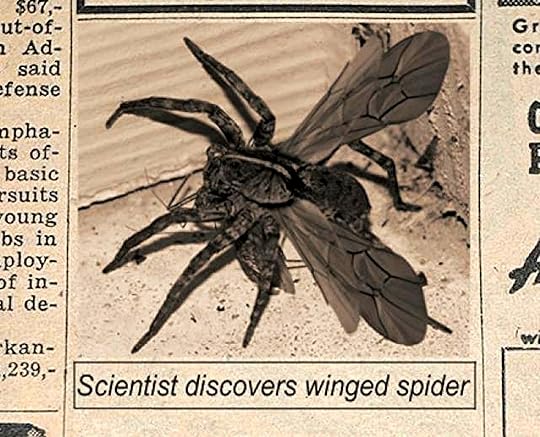
Never in the long and very diverse history of spiders – a very significant arachnid order (Araneae) whose lineage dates back more than 300 million years according to the known fossil record – has there ever been a spider with wings. And why should there be? Virtually all spiders display a lifestyle that has no place or need in it for wings, relying upon stealth and ambush to survive and to capture their prey, not flamboyant aerial activity like some bizarre eight-legged dragonfly. Nevertheless, this has not prevented flying spiders from winging their way every so often through both hard-copy and online media reports – to the delight of connoisseurs of the strange and uncanny, and to the despair of hardcore arachnophobes! So here are three of the most entertaining and engrossing accounts that I have seen which showcase these faux yet fabulous fliers of the spider kind.
A WINGED TERROR ON TUMBLR
During 2012, several users of the website Tumblr posted online what initially looked like a bona fide but unidentified newspaper clipping of a supposedly newly-discovered species of winged spider. The clipping consisted of a b/w photograph of the spider in question, entitled 'Scientist discovers winged spider', but with no accompanying details concerning it or its discovery. A close look at the photo, however, soon revealed that it was a not-especially efficient exercise in image manipulation of the photoshopped variety. The spider depicted was in fact a common (and wingless!) species of fishing (aka raft) spider belonging to the genus Dolomedes.
 The fake report of a winged spider featuring a photoshopped image of an ordinary wolf spider (creator/s unknown)
The fake report of a winged spider featuring a photoshopped image of an ordinary wolf spider (creator/s unknown)In addition, as later revealed on the famous hoax-busting Snopes website as well as on several others too, the original photograph of it that had subsequently been manipulated by person(s) unknown to yield the winged spider is one that had been snapped on 23 September 2007 at Durham in North Carolina by Will Cook from Duke University in Durham, and had appeared (it still does in fact) on the website North Carolina Spider Photos ( here is a direct link to this photo on the latter website).
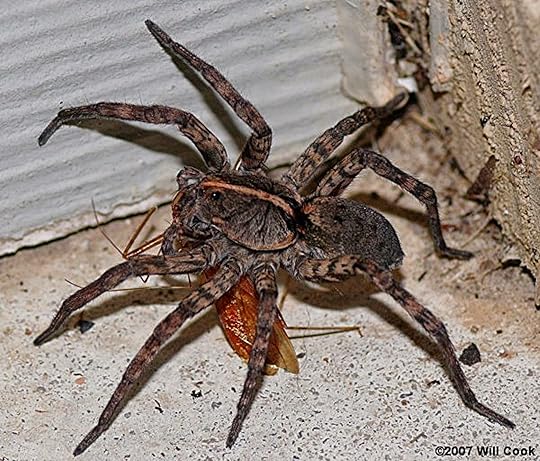 Will Cook's original, undoctored photograph of a Dolomedes wolf spider (© Will Cook)
Will Cook's original, undoctored photograph of a Dolomedes wolf spider (© Will Cook)On 10 March 2014, the fake clipping and photo were revisited by the website of a UK computer services company, Digital Plumbing, which provided an extensive report about them, including details of how the winged spider, which in this report was unscientifically named Volat-Araneus (it should have been the other way around and italicised, of course, i.e. Araneus volat, if the aim was for it to resemble a genuine taxonomic binomial), preyed upon the poisonous (and real) false widow spider Steatoda nobilis.
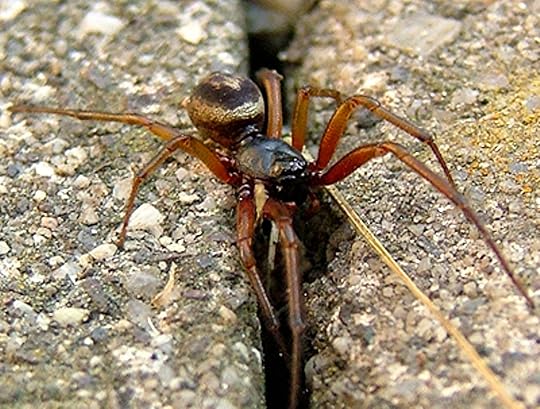 A false widow spider Steatoda nobilis (public domain)
A false widow spider Steatoda nobilis (public domain)However, the report was peppered with clues that it was a hoax, and indeed, halfway through it its (unnamed) writer confessed this openly, explaining that the report's sole purpose had been to attract the attention of readers, who would now, the writer hoped, take note that this website was that of a company offering technology repairs and other services, as detailed in the remainder of the report. In short, Digital Plumbing's report was a very novel marketing ploy, quite possibly the first one ever to utilise a non-existent winged spider to attract potential customers.
A WINGED SPIDER VIDEO AND A WINGLESS MISNOMER
Flying spider #2 has only appeared once (to my knowledge) – as an even less convincing photoshopped image presented in an extremely brief YouTube video uploaded on 15 October 2013 by Brian Griffin under the title 'Have Scientists Discovered a Winged Spider?' (click here to watch it).
In it, mention is made of the fact that a species called the long-winged kite spider is already known to science. This is perfectly true, the species in question being a forest-dweller known formally as Gasteracantha versicolor, which is native to the subtropics and tropics of eastern, central, and southern Africa, as well as Madagascar. However, 'long-winged' is something of a misnomer, because its 'wings' are not of the membranous, flight-producing variety. Instead, they are a pair of immobile sclerotised spines, borne laterally upon the opisthosoma or abdominal section of this spider's body in the adult female.
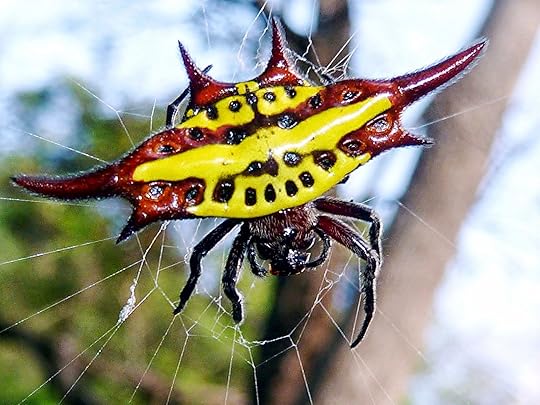 Gasteracantha versicolor
, female, in South Africa's Krantzkloof Natuurreservaat (© JMK/Wikipedia)
Gasteracantha versicolor
, female, in South Africa's Krantzkloof Natuurreservaat (© JMK/Wikipedia)THE ITALIAN TOMB SPIDER – ENCOUNTERED IN THE CATACOMBS
Far older and also far more intriguing than the previous two examples is the third member of this trio of winged wonders – albeit this time a truly grotesque Lovecraftian horror, a cryptic cryptid from the crypts in fact, known as the Italian tomb spider.
I first learnt of this macabre entity courtesy of British cryptozoological archive peruser Richard Muirhead, who sent me an unlabelled review report of an article that had originally appeared in the Pall Mall Gazette. Happily, I was soon able to trace the original source of this review report – namely, the San Francisco Call, which had published it on 29 November 1896. The report makes such compelling if unnerving reading that I am reproducing it in its entirety below – the first time, as far as I am aware, that it has ever appeared in an online cryptozoological article:
San Francisco Call , Volume 80, Number 182, 29 November 1896
ITALY'S TOMB SPIDER
A Thing So Odd That It is Believed to Exist Only in Imagination.
The people of Italy believe in the existence of a wonderful creature which, for the want of a better name, is called the tomb spider. The entomologists know nothing of this queer beast, and declare that it only exists in the fancy of the superstitious persons and those whose curiosity or business makes it necessary for them to explore old ruins, tombs, catacombs, etc. According to the popular account the tomb spider is of a pure white color, has wings like those of a bat, a dozen horrid crooked legs and a body three or four times the size of the largest tropical American tarantula.
The accounts of this queer insect and his out-of-the-way places of abode are by no means common, and on that account the information concerning him which we will be able to give the "curious" is very meager. Any Italian will tell you that such a creature exists, however, and that he is occasionally met with in old mines and caverns, as well as in tombs and subterranean ruins. The London Saturday Review has an article from a correspondent who was present when some Roman workmen unearthed a church of the fifth century. He says: "We were standing by one of the heavy pillars that had originally supported the roof, when something flashed down from the pitchy darkness overhead and paused full in the candle-light beside us, at about a level with our eyes. It was distinctly as visible as a thing could be at a distance of three feet, and appeared to be an insect about half the size of a man's fist, white as wax and with its many long legs gathered in a bunch as it crouched on the stone.
"Our guide had seen, or at least heard of this uncanny insect of ill omen before, but was by no means reconciled to its presence, as his notions proved. He glanced around uncomfortably for a moment and then moved away, we following. It seems really a bit queer, but it is said that the strongest nerves give way in the presence of this insect of such ghostly mien. Even today this uncanny apparition is said to be an unclassified monster — an eternal mystery. When the grave spider is encountered by those opening tombs and vaults it is thought to be a 'sign' of death to one of the workmen or some member of his family." - Pall Mall Gazette.
An almost identical account also appeared in another American newspaper, the Sausalito News, on 23 January 1897.
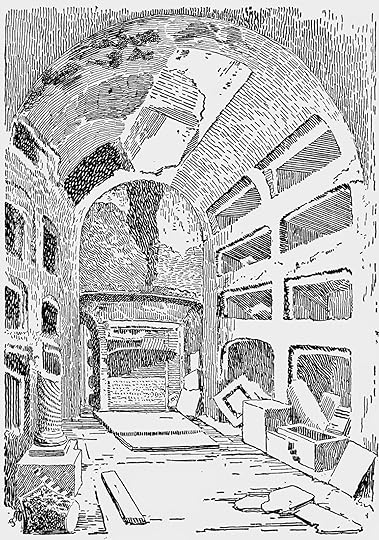 Vintage engraving of catacombs
Vintage engraving of catacombsWhat can we say about such a bizarre report? The spider, if indeed we can apply such a name to a creature sporting wings and a dozen legs, is unlike any life form known either upon or beneath the surface of Planet Earth, even if we generously assume that it may be a grossly exaggerated or embroidered description of a pallid form of bat or an exceptionally large moth.
Interestingly, as I documented in my book The Encyclopaedia of New and Rediscovered Animals (2012), a dramatically new species of large cavernicolous spider with a pure white abdomen (opithosoma) was discovered by science in quite recent times, amid the deeper regions of Koloa Cave on the Hawaiian island of Kauai and a few others on this same island's southeastern coast, yielding six populations in total. Formally dubbed Adelocosa anops in 1973, this spelaean spider (sole member of its genus) delights in a very contradictory common name - the no-eyed big-eyed wolf spider! The reason for this stems from Adelocosa's membership of a taxonomic family of wolf spiders whose species are generally typified by very large, well-developed eyes, and are thus called big-eyed wolf spiders. In the case of Adelocosa, however, its ancestors apparently abandoned a traditional above-ground lifestyle in favour of a highly-specialised subterranean one instead - in which eyes were superfluous. Consequently, during the resulting evolution of this much-modified cave-dwelling species, they were eventually lost, thus explaining the apparent paradox of a no-eyed big-eyed spider.
Although made known to science only fairly recently, this distinctive spider has long been familiar to Kauai's indigenous people, who call it pe'e pe'e maka'ole. It is easily identified not only by its lack of eyes but also by its long and semi-transparent, orange-coloured legs (the normal complement of eight in number), its orange-brown cephalothorax (combined head-and-body section), and its ghostly white opisthosoma. Needless to say, however, it does not possess wings!
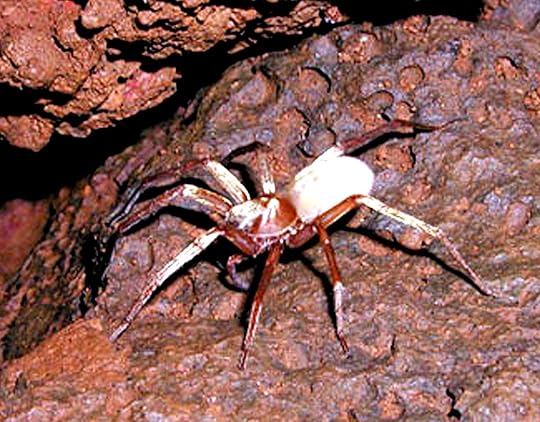 The Hawaiian no-eyed big-eyed spider (public domain)
The Hawaiian no-eyed big-eyed spider (public domain)As for the Italian tomb spider that does allegedly possess wings, conversely: during the 19th Century, gruesome, highly fanciful yarns of this nature were a popular genre of journalistic reportage, invented purely for entertainment purposes and never meant to be taken seriously, although they sometimes were – especially by the more credulous and less perspicacious of readers. In my opinion, this San Francisco Call report from 1896 is clearly a prime example from such a genre.
Having said that, however, I'd still be interested to read the article from the London Saturday Review referred to in the latter report (always assuming that such an article does exist), just in case its telling of the tale of Italy's dreaded tomb or grave spider is any less lurid and rather more believable. After all, even an account of a wingless spider sporting only the standard octet of legs typical for its kind but which is unusually large in size, is ghostly-white in colour, and exclusively inhabits crypts, catacombs, and other subterranean residences of the deceased would be sufficiently distinct from all recognised spider species to warrant more than passing interest from arachnologists and cryptozoologists alike.
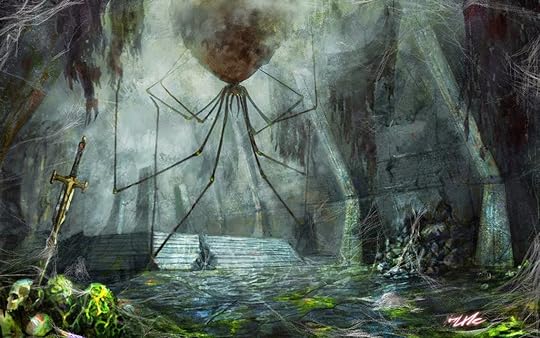 'Spider's Room' (© Minhee-Kim/Deviantart)
'Spider's Room' (© Minhee-Kim/Deviantart)So if anyone reading this present ShukerNature blog article can trace and send to me a copy of the relevant Saturday Review article, I'd very much like to see it – thanks very much!
BALLOONING SPIDERS AND ANGEL HAIR
Finally: although spiders, being wingless, cannot actively fly, some species can and do practise a type of passive gliding known as ballooning, which is often linked directly to a semi-mysterious phenomenon known as angel hair.
Angel hair is the name given to long, white, gossamer-like filaments that descend earthward often in vast quantities, cloaking meadows, streets, houses, or anything else that they land upon with their ethereal, silken strands. But what isangel hair - and where does it come from? Many eyewitnesses describe angel hair as resembling spider webs, and in most (though not all) cases this is indeed what it probably is (but see my book Dr Shuker's Casebook (2008) for some angel hair reports that clearly do notinvolve spider gossamer).
 A sheet web composed of gossamer and woven by Linyphia hortensis, a species of money spider (Wikipedia)
A sheet web composed of gossamer and woven by Linyphia hortensis, a species of money spider (Wikipedia)Very few reports of angel hair actually mention the presence of spiders amid the shroud-like sheets and threads drifting downwards or discovered festooning the ground. Yet there is little doubt that this gauzy, filamentous material is merely an aggregation of threads produced by congregations of tiny money spiders (belonging to the family Linyphiidae) in order to become airborne by a process known as ballooning.
 A money spider (public domain)
A money spider (public domain)Silken threads drawn out of their spinnerets when the spiders face a strong wind are lifted, together with the attached spiders, into the air by the wind and carried aloft, the spiders sometimes travelling great distances before finally gliding back to earth. Once there, they simply abandon their threads, yielding spiderless, gossamer-like sheets called angel hair - as confirmed on several occasions by analysis of samples collected.
In short: apart from ballooning spiders, these eight-legged arachnids are reassuringly earthbound, and all are indefatigably wingless – unless you live in Italy and are well-versed in folklore appertaining to grim subterranean realms, and featuring encounters with monstrous creatures that never penetrate up into the light of day, something for which we can all be very thankful, especially if the tomb spider is a typical respresentative of this shadowy fauna of the catacombs and crypts.

Published on March 02, 2015 08:35
February 16, 2015
MOTTY AS AN ADULT? – IS THIS WHAT THE WORLD'S ONLY INTERGENERIC HYBRID ELEPHANT WOULD HAVE LOOKED LIKE HAD HE SURVIVED TO MATURITY?
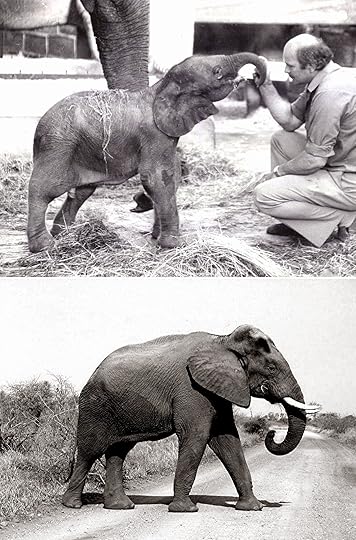 Motty as a calf (above) and a photo-manipulated image (below) of what he may have looked like had he survived to adulthood (photo courtesy of Derek G. Lyon/Chester Zoo; photo-manipulation by Paul Willison of public-domain photograph of adult bull African elephant)
Motty as a calf (above) and a photo-manipulated image (below) of what he may have looked like had he survived to adulthood (photo courtesy of Derek G. Lyon/Chester Zoo; photo-manipulation by Paul Willison of public-domain photograph of adult bull African elephant)For 11 days, a little elephant calf called Motty was the world's first (and remains its only) intergeneric hybrid elephant, resulting from an unanticipated mating between a male African elephant Loxodonta africana and a female Asian elephant Elephas maximus at Chester Zoo, England, in July 1978. In my previous ShukerNature article (click here ), the second of two documenting this truly unique animal (click here for my first one), I mentioned that I had often wondered what Motty would have looked like if he had survived to maturity, and I mourned the fact that we shall never know. This is of course perfectly true, we can only speculate – but now, I'm delighted to reveal that such speculation has acquired an astonishing and thoroughly fascinating visual form.
Facebook friend and computer art enthusiast Paul Willison shares my interest in what the adult appearance of Motty might have been. Consequently, after reading both of my Motty articles and noting that in overall body form (especially with regard to his long slimmer legs and large triangular, pointed ears) Motty seemed somewhat closer to Loxodonta than Elephas, Paul used his photoshop skills to transform the adult bull African elephant present in each of two public-domain photographs into what may conceivably be accurate images of Motty as a fully-mature elephant. Paul utilised as his morphological guides the photographs of Motty as a calf that appear in my articles, plus my detailed verbal description of him, which was based in turn upon an official account of Motty prepared by Derek G. Lyon, who was Chester Zoo's chief veterinary surgeon at the time of this remarkable little elephant's existence there.
And here they are.
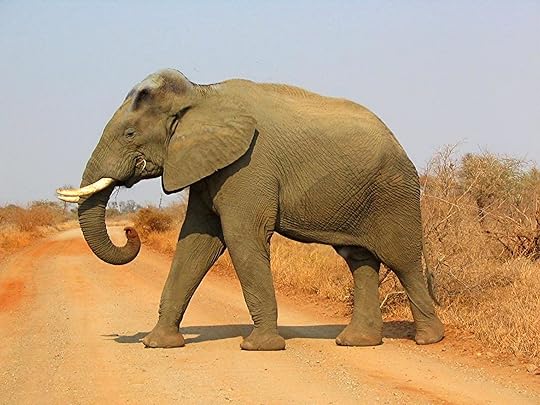 Photoshopped adult bull African elephant #1, now exhibiting the unique complement of morphological characteristics possessed by Motty as a calf (public domain image photo-manipulated by Paul Willison)
Photoshopped adult bull African elephant #1, now exhibiting the unique complement of morphological characteristics possessed by Motty as a calf (public domain image photo-manipulated by Paul Willison)And:
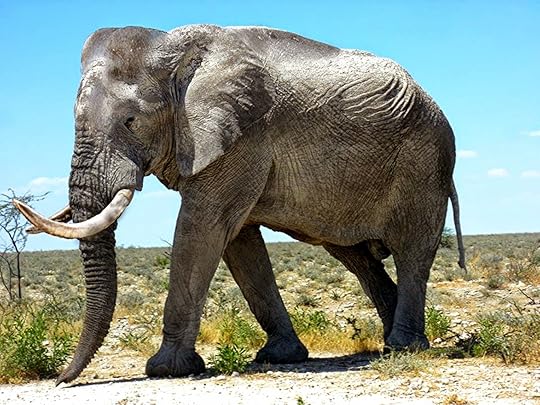 Photoshopped adult bull African elephant #2, now exhibiting the unique complement of morphological characteristics possessed by Motty as a calf (public domain image photo-manipulated by Paul Willison)
Photoshopped adult bull African elephant #2, now exhibiting the unique complement of morphological characteristics possessed by Motty as a calf (public domain image photo-manipulated by Paul Willison)If these two photographs are directly compared with their respective original, non-photoshopped versions (see below), it can be readily seen how Motty's composite, intergeneric morphology might well have yielded when translated into adult form an elephant that looked dramatically different from any that had ever been seen before, one that was singularly imposing and impressive.
For although he is likely to have retained the overall stature and body proportions of his African elephant father as well as his single large frontal skull dome, Motty would also most probably have retained his paired posterior skull domes inherited from his Asian elephant mother, as well as her species' very distinctive convex back, greater number of toes per foot, and her single trunk-tip digit – features that do not occur in African elephants (the latter possess two trunk-tip digits).
 Original, unmodified African elephant photo #1 (above), and the 'Motty-fied' version (below) (public domain; public domain image photo-manipulated by Paul Willison)
Original, unmodified African elephant photo #1 (above), and the 'Motty-fied' version (below) (public domain; public domain image photo-manipulated by Paul Willison)And:
 Original, unmodified African elephant photo #2 (above), and the 'Motty-fied' version (below) (public domain; public domain image photo-manipulated by Paul Willison)
Original, unmodified African elephant photo #2 (above), and the 'Motty-fied' version (below) (public domain; public domain image photo-manipulated by Paul Willison)Nor is this the end of the story. As Paul swiftly recognised and brought to my own attention after completing his photo-manipulations, the resulting images predicting the possible adult appearance of Motty bear more than a passing resemblance (aside from shorter tusks and larger ears) to a certain proboscidean that is spectacularly different from anything alive today – nothing less, in fact, than the gargantuan Columbian mammoth Mammuthus columbi, one of the most awe-inspiring prehistoric mammals of all time.
Native to North America and traditionally believed to have become extinct around 12,500 years ago (but possibly a few millennia later, due to the existence of certain contentious fossil remains that have yielded more recent dates), adult males of this stupendous creature stood 13 ft tall at the shoulder, even overshadowing all but the most exceptional of today's African elephants. It also sported enormous tusks, almost 14 ft long in some instances.
Yet due to this species' very close taxonomic affinity to the woolly mammoth M. primigenius (indeed, DNA evidence suggests that the Jefferson mammoth M. jeffersonii of North America might actually have been a naturally-occurring hybrid of the Columbian mammoth and woolly mammoth), it may well have possessed characteristics recalling Elephas, because the woolly mammoth is certainly more closely related to the modern-day Asian elephant genus than to the African one.
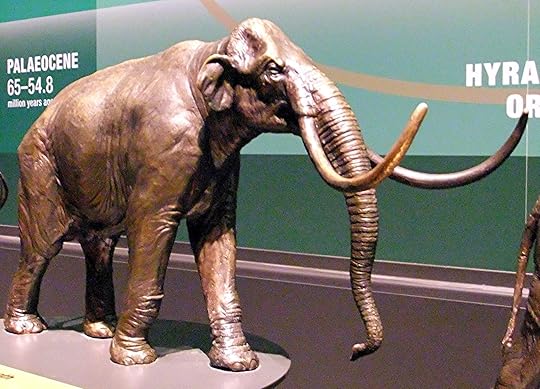 Model of the Columbian mammoth on exhibition last year at the Natural History Museum, London (© Dr Karl Shuker)
Model of the Columbian mammoth on exhibition last year at the Natural History Museum, London (© Dr Karl Shuker)Also worthy of note here is that some mammalian hybrids, ligers (lion x tigress hybrids) being a well-known example, actually attain dimensions exceeding those achieved by both of their progenitor species. Is it possible, therefore, that an adult Motty might have surpassed even his African elephant father in stature, thereby providing yet another parallel with the mighty Columbian mammoth?
Of course, all of this is speculation – entertaining, certainly, but completely speculative nonetheless. Even so, perhaps we should not be too surprised after all to discover that Motty, a hybrid deftly combining the African elephant's basic build and proportions with the more specific idiosyncrasies of the Asian elephant, may in adulthood have superficially recalled the Columbian mammoth – a fascinating outcome that, if correct, makes his demise even more tragic than ever, our modern-day world possibly having lost the nearest morphological evocation of the majestic but long-bygone Columbian mammoth that anyone will ever see.
My sincere thanks to Paul Willison for so kindly preparing and making available to me for inclusion here the photo-manipulated images of Motty's possible adult appearace.
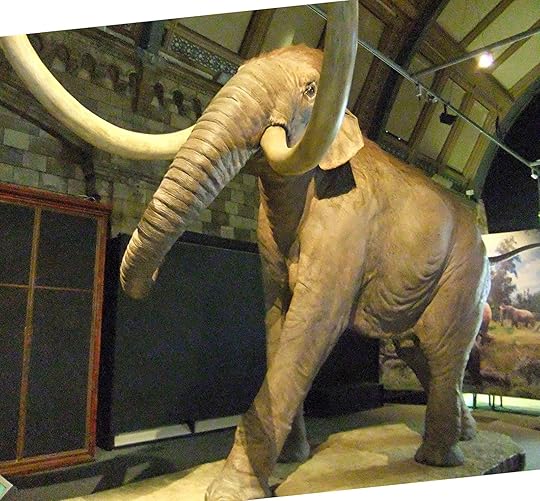 Life-sized model of the Columbian mammoth on exhibition last year at the Natural History Museum, London (© Dr Karl Shuker)
Life-sized model of the Columbian mammoth on exhibition last year at the Natural History Museum, London (© Dr Karl Shuker)
Published on February 16, 2015 07:27
February 13, 2015
THE RETURN OF MOTTY, THE MIRACLE HYBRID ELEPHANT - UNVEILING SOME NEVER-BEFORE-SEEN PHOTOGRAPHS OF HIM!
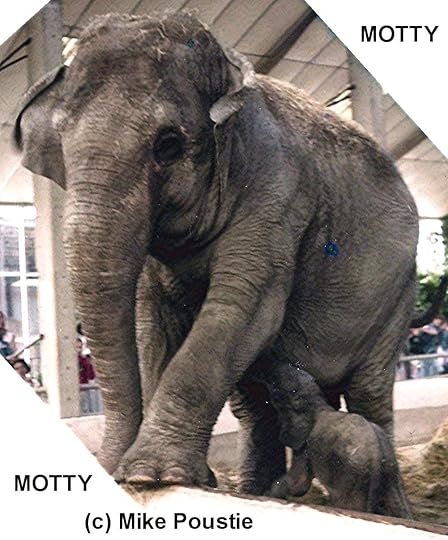 Motty and his mother at Chester Zoo, July 1978 (© Mike Poustie, c/o Chris Poustie)
Motty and his mother at Chester Zoo, July 1978 (© Mike Poustie, c/o Chris Poustie)In an earlier ShukerNature article (click here ). I documented the birth and tragically-short but zoologically-immortal, never-to-be-forgotten life of a truly unique animal – a little elephant called Motty. He has been referred to as the miracle elephant, and for good reason, because he was something that science had previously rejected as an outright impossibility – a hybrid between an African elephant Loxodonta africana (Motty's father) and an Asian elephant Elephas maximus (Motty's mother). No intergeneric elephant hybrid had ever been recorded before, and none has since, and almost certainly never will be ever again.
Motty was born at Chester Zoo, England, on 11 July 1978, but his arrival was totally unanticipated by everyone at the zoo, because although a male African elephant was being maintained together with some female Asian elephants there and had been seen mating with them, no-one had expected any offspring to result from such liaisons, because the genetic differences between the two genera that the African and Asian elephants respectively represent were deemed too great for such an event to occur. But somehow, incredibly, an offspring did result – Motty. Sadly, however, just 10 days after his zoologically historic birth, little Motty died, and a post-mortem revealed that he had been suffering from an unsuspected outbreak of necrotic enterocolitis plus E. coli septicaemia.
Motty was subsequently preserved as a taxiderm specimen and has been held ever since in the vast stores of London's Natural History Museum, but he has never been publicly displayed, which is a great shame, because such an extraordinary animal would surely attract considerable attention and interest.
 Head-and-back view of Motty with his mother (© Mike Poustie, c/o Chris Poustie)
Head-and-back view of Motty with his mother (© Mike Poustie, c/o Chris Poustie)Due to his all-too-brief existence, very few images of Motty exist. However, he was photographed by Derek G. Lyon, who was Chester Zoo's chief veterinary surgeon at that time, and Derek has very kindly made his photos of Motty available to me to incorporate in any of my writings. Some of these pictures were duly included, therefore, in my previous Motty article on ShukerNature. As seen when viewing them (click here ), they readily reveal the complex intermingling of morphological characteristics drawn from Motty's two very different progenitor species and embodied in his own singular appearance.
Now, moreover, I am delighted and very excited to announce that some additional Motty photographs have been brought to my attention – photos that have never previously been seen in public, but which, once again, have very kindly been made available to me by their owner for inclusion in my writings.
On 24 May 2013, a reader who identified himself only as Chris posted a short message beneath my original Motty article on ShukerNature informing me that he had actually seen Motty alive during a visit to Chester Zoo in mid-July 1978 with his father and brother when he was 6 years old, and that his father had snapped some colour photos of Motty. Chris promised to scan and email the photos to me if I'd like to see them. I swiftly confirmed that I would definitely like to see them, and on 3 January 2015 Chris sent them to me, revealing that his full name was Chris Poustie and his father's was Mike Poustie. Moreover, in a follow-up email, he stated that both of them were happy for me to utilise the photos as I wished in my publications and researches.
So now, officially unveiling them as a ShukerNature world-exclusive, here are some of the Poustie photos of Motty, interspersed throughout this present ShukerNature article – thanks very much, Mike and Chris!
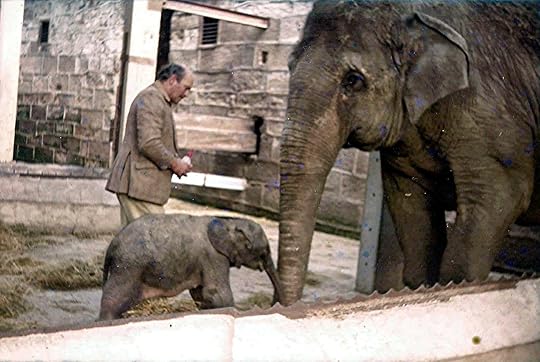 Detailed view of Motty with his mother (© Mike Poustie, c/o Chris Poustie)
Detailed view of Motty with his mother (© Mike Poustie, c/o Chris Poustie)Once again, as with Derek's photos, they perfectly capture for all time Motty's fascinating intergeneric morphology, a composite creation unlike any other, and proof that whatever the odds, however implausible the prospect, somehow life will always find a way to express itself.
Whenever I think of Motty, I always wonder what he would have looked like had he survived to maturity. Would he have retained his unique combination of characters from both species, or would those inherited by him from one species have largely obliterated those inherited by him from the other? Might he have attained the huge size of his father – indeed, might he have even surpassed it, just like ligers (lion x tigress hybrids) often exceed the dimensions of both of their progenitor species?
Sadly, we will never know, and can only ever speculate. However, I feel sure that whatever appearance Motty would have assumed as an adult, it could not have been anything other than magnificent and marvellous – just as marvellous, in fact, as his very existence had been, and always will be.
 Full view of Motty with his mother (© Mike Poustie, c/o Chris Poustie)
Full view of Motty with his mother (© Mike Poustie, c/o Chris Poustie)
Published on February 13, 2015 16:05
February 12, 2015
ARNOLD'S GIANT TORTOISE AND THE HOLOLISSA OF SEYCHELLES - LONG FORGOTTEN, BUT NO LONGER GONE
 Aldabra giant tortoise (left) and hololissa (right) at Cotswolds Wildlife Park, showing shell differences (© Dr Karl Shuker)
Aldabra giant tortoise (left) and hololissa (right) at Cotswolds Wildlife Park, showing shell differences (© Dr Karl Shuker)The New World giant tortoises famously inhabiting the Galapagos Islands off Ecuadorin the Pacific Oceanwere once rivalled for size by several huge Old World species native to the Indian Ocean's granitic Seychellesgroup, the coral atoll of Aldabra, the Mascarene islands, and Madagascar. Of these, only the Aldabra giant tortoise Aldabrachelys [=Dipsochelys] gigantea [=dussumieri, =elephantina] is traditionally thought to have survived into the present day, the remainder having been killed for their meat during the 1700s and 1800s - or so it was thought, until Arnold's giant tortoise and the hololissa unexpectedly reappeared in modern times.
There has been much debate concerning the precise number of giant tortoise species native to the Seychelles. Four are currently recognised (although some researchers deem them merely to be subspecies of a single species), one of which was formally described in September 1982, by Dr Roger Bour from France's National Museum of Natural History. He based his description upon three old taxiderm specimens (two at the above museum, the third at the British Museum). They possessed various skeletal modifications that seemed to be adaptations to browsing, and originated from the granitic Seychellesislands. Bour named their species Dipsochelys [now Aldabrachelys]arnoldi, but as there did not seem to be any giant tortoises (other than Aldabra's) in the Seychellestoday, he naturally assumed that it was extinct - belatedly recognised as a distinct species, yet irretrievably deceased.
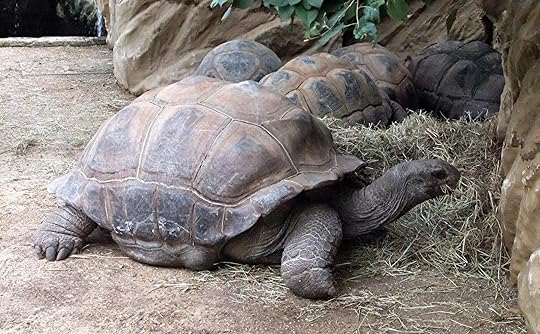 Aldabra giant tortoises (© Dr Karl Shuker)
Aldabra giant tortoises (© Dr Karl Shuker) Imagine, then, his surprise when, while still preparing his paper, Bour was shown some photos by film producer Claud Pavard (who had taken them in August 1981) depicting two living giant tortoises that seemed to belong to his supposedly extinct species A. arnoldi. Nor was this the only surprise. The tortoises, males and very old, were living in semi-captivity at a sugar estate, but not in the Seychelles- instead, on Mauritius! Naturally, Bour hoped to visit Mauritius, to ascertain conclusively these potentially significant specimens' identity.
And that is where this most promising saga seemed to come to an abrupt end. During my preparation of my book The Lost Ark , published in 1993 and the first in my trilogy of volumes documenting new and rediscovered animals from 1900 onwards, I was unable to locate a single publication carrying any further news regarding these tortoises, and none of my zoological colleagues and correspondents had any details (sadly, I never succeeded in eliciting a reply from Dr Bour himself), though they were all as intrigued by it as I was. Happily, however, the mystery was finally solved in May 1992, when I learnt from British Museumherpetologist Dr Nick Arnold (after whom A. arnoldi had been named) that Dr Bour had indeed visited the two Mauritiusspecimens, but had found that they were not representatives of A. arnoldiafter all.
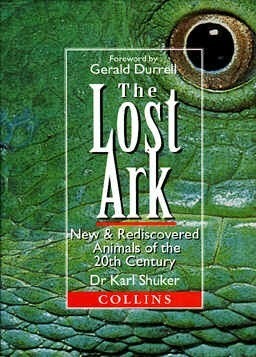 The Lost
Ark
: New and Rediscovered Animals of the 20th Century
(HarperCollins: London, 1993) (© Dr Karl Shuker)
The Lost
Ark
: New and Rediscovered Animals of the 20th Century
(HarperCollins: London, 1993) (© Dr Karl Shuker)Moreover, Dr Ian Swingland, Founding and Research Director of the Durrell Institute of Conservation and Ecology (DICE), informed me that giant tortoises reared in captivity sometimes have shells that have become distorted in shape, due to the way in which these animals have been fed. In some cases, therefore, it is possible that they may even resemble the shells of quite unrelated species, and this is presumably what had happened in the case of the two Mauritiusspecimens, which were probably individuals originating from Aldabra. Captivity-induced distortion of shell shape can cause problems for tortoise taxonomists too, especially if they are dealing with specimens whose life histories are unknown (and which, therefore, may have been reared in captivity).
Of course, one objection that could immediately have been raised in relation to this entire episode is the fact that supposed specimens of A. arnoldi were discovered not in the Seychelles, but instead in Mauritius. As it happens, however, this objection can be effectively countered - because a number of giant tortoises from the Seychellesare known to have been introduced there after that island's own indigenous species had been exterminated during the 1700s. In particular, the French explorer Marion de Fresne transported five such specimens in 1776 from the Seychellesto his military barracks on Mauritius. What was assumed to be the last of this quintet died there in 1918, but there may have been others too, whose records have failed to survive to the present day.
 A pair of Aldabra giant tortoises mating - intriguingly, the top specimen has a markedly flat-backed shell, resembling the saddle-backed shell of Arnold's giant tortoise (public domain)
A pair of Aldabra giant tortoises mating - intriguingly, the top specimen has a markedly flat-backed shell, resembling the saddle-backed shell of Arnold's giant tortoise (public domain) In any event, what did seem clear at the time of writing The Lost Ark was that none of the long-lost species of Seychellesgiant tortoise had been resurrected after all. During 1995, however, another discovery was made - one that added a new and much more dramatic chapter to this long-running saga of mistaken and incognito identities.
In January of that year, the Nature Protection Trust of Seychelles (NPTS) learnt of two very large, and very old, male tortoises living in the garden of a Seychelleshotel. When examined by Dr Justin Gerlach and K. Laura Canning, chief scientists with the NPTS, they were found to exhibit pronounced flaring, flattening, and scalloping of the carapace, especially over the hind legs - characteristics that distinguished them from the Aldabra giant tortoise but corresponded closely with those of Arnold's supposedly long-extinct species.
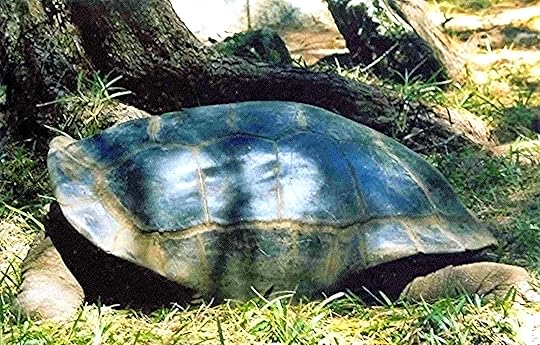 Arnold's giant tortoise (© Editha@emys-home.de /Wikipedia)
Arnold's giant tortoise (© Editha@emys-home.de /Wikipedia)Enquiries revealed that these and one other male specimen had been purchased in 1994 from an old local man, in whose family they had been throughout living memory. The third had died in December 1994, but its skeleton was preserved and donated to the NPTS's scientific collections. Cranial studies subsequently determined that it was indeed distinct from the Aldabra species. Genetic studies were also set in motion, to bypass any possible misclassification based solely upon morphological characteristics - which can, as already ably demonstrated with the earlier episode of the Mauritiusspecimens, be very deceptive.
By early 1997, several additional specimens of unusual giant tortoise had been discovered in various Seychelleslocalities and examined by Gerlach. Moreover, whereas some of these resembled Arnold's giant tortoise, eight others closely recalled a second supposedly long-vanished species - the hololissa Dipsochelys [now Aldabrachelys] hololissa. Previously, this latter species had been known only from two shells found in 1810, described in 1877, and destroyed in the 1940s by German bombing raids during the London Blitz. It formerly inhabited various granitic islands of the Seychelles, where it grazed vegetation on the edges of streams and marshes, but had vanished in the wild by 1840.
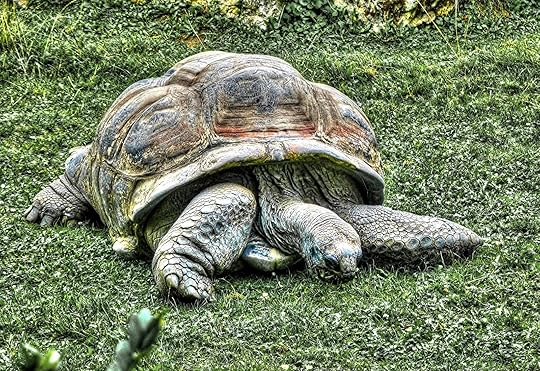 Hololissa at Prague Zoo (© travelviaitaly/Wikipedia)
Hololissa at Prague Zoo (© travelviaitaly/Wikipedia)In March 1997, Dr Les Noble conducted genetic tests at Aberdeen Universityon blood samples taken by Gerlach from a large selection of live Seychellesgiant tortoises, including the controversial ones. These tests showed that three distinct groups could be identified, revealing that eight of the specimens were hololissas, two were Arnold's giant tortoises, and the remainder were Aldabra giants. But this was still not the end of the story.
A year later, Blackpool Zoo in England announced that Darwin, the Aldabra giant tortoise that had been living there for the past 25 years, was not a member of the Aldabra species after all. While closely scrutinising photos of recently-discovered living specimens of the hololissa, staff at the zoo were astonished to discover that they looked just like Darwin. Anxious to learn more, they duly contacted Gerlach, who visited the zoo, examined Darwin, and confirmed that he was indeed a living hololissa. This presumably explains why he has never successfully mated with Beagle, the female Aldabra giant tortoise that accompanied him when he arrived at Blackpoolin 1972 - because they belong to separate species.
 Hololissa at Cotswolds Wildlife Park (© Dr Karl Shuker)
Hololissa at Cotswolds Wildlife Park (© Dr Karl Shuker)Similarly, I subsequently learnt from the Cotswold Wildlife Park, alsoin England, that one of their supposed Aldabra giant tortoises had also been unmasked as a hololissa. Moreover, by the end of 1999 at least 12 living hololissa individuals and 18 living individuals of Arnold's giant tortoise had been revealed in various locations around the world, including a very impressive specimen at Prague Zoo in the Czech Republic.
Snapped in 1905 when its subject was still alive on Mauritius, a vintage black-and-white photograph still exists of what is now believed by some researchers to have been a hololissa, taken there from its native Seychelleshomeland in 1764. Living in the Court House Garden on Mauritius, this venerable individual was therefore at least 140 years old at the time of being photographed, but was probably much older, because no-one knows how old it already was at the time of its transportation there from the Seychelles.
 Possible hololissa on Mauritius, vintage 1905 photograph (public domain)
Possible hololissa on Mauritius, vintage 1905 photograph (public domain)All of which invites speculation as to how many other incognito specimens of hololissa and Arnold's giant tortoise may still be awaiting identification elsewhere. By the end of 1997, the NPTS had introduced several specimens of hololissa and Arnold's giant tortoise to Silhouette Island (third largest of the central Seychelles islands) in order to initiate captive breeding programmes for both of these recently-revived species and thus ensure their continuing survival, and it continues to search for more possible examples in captive collections worldwide.
Officially known as the NPTS Seychelles Giant Tortoise Conservation Project, its patron is veteran wildlife film maker and broadcaster David Attenborough. Its long-term goal is to increase the numbers of both species in order to permit reintroduction to secure reserve sites within the Seychellesgroup - thereby restoring in viable form two remarkable endemics to their native island homeland after more than 150 years of 'official' non-existence.
 Child riding Aldabra giant tortoise at Mount KenyaWildlife Conservancy, readily demonstrating just how large these tortoises are (Wikipedia/public domain)
Child riding Aldabra giant tortoise at Mount KenyaWildlife Conservancy, readily demonstrating just how large these tortoises are (Wikipedia/public domain)All that now remains to be accomplished in order for this tale of tortoise resurrection to be complete is for the fourth species of Seychellesgiant tortoise – D. [now Aldabrachelys] daudinii, Daudin's giant tortoise – to be rediscovered. Known only from the Seychellesisland of Mahéand named in honour of French zoologist François Marie Daudin (1776-1803), it was formally described and named in 1835, but officially became extinct in 1850.
Judging from the recent success in revealing hitherto-unrecognised living specimens of the hololissa and Arnold's giant tortoise, however, who can say with absolute certainty that there are no incognito A. daudinii individuals out there somewhere too, alive and well but in blissful ignorance of the fact that their species is officially long-extinct?! To be continued…?
This ShukerNature article is expanded and updated from my book The Encyclopaedia of New and Rediscovered Animals (2012).
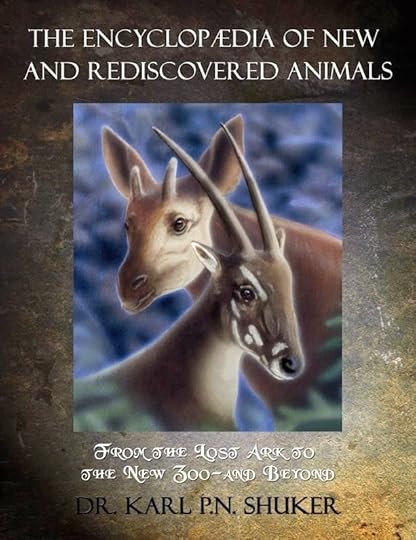
Published on February 12, 2015 20:59
February 10, 2015
SURREAL SYNCEPHALI – A TRIPLICATE LAMB FROM HUNGARY, AND RIPLEY'S DOUBLE-BODIED DONKEY
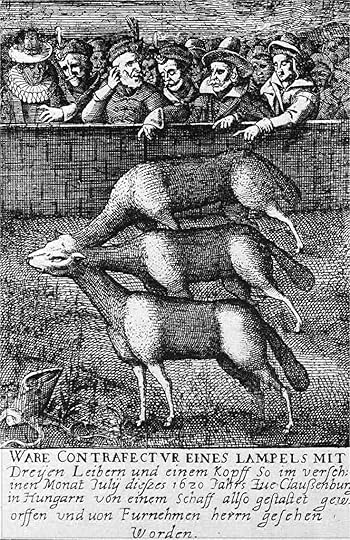 Engraving of an extraordinary triple-bodied, single-headed lamb that reputedly existed in Hungary in 1620
Engraving of an extraordinary triple-bodied, single-headed lamb that reputedly existed in Hungary in 1620Many years ago, a correspondent sent me a photocopy of the remarkable engraving that opens this present ShukerNature article. It depicts what was allegedly a living lamb with three fully-formed bodies united by a single head. According to the caption included in the engraving, this extreme developmental monstrosity (the study of such freaks is known as teratology, which translates as 'the study of monsters') had been seen in Klausenburg, Hungary, during July 1620. (Incidentally, I have never been able to trace the original source of this engraving, so if anyone reading my article has any information concerning it, I'd welcome all details. Also: Klausenburg was technically part of Transylvaniaduring the 1600s, which in turn was assimilated into Hungary before eventually becoming part of present-day Romania.)
A developmental monstrosity born with a single head but two bodies is known technically as a syncephalus or monocephalus, and is basically a pair of incompletely-separated (conjoined) twins in which, during embrogeny, the head (cephalic) portion of the originally-single embryo has not differentiated into two separate heads but has instead remained as a solitary undivided unit, thus developing into only a single head, whereas the body portion of the originally-single embryo has split into two halves with each half developing into a body. (Less common and more deleterious to survival is the reverse derivation of a syncephalus, in which a pair of separate twins originally develop but the heads of the two twins subsequently fuse during embryogeny with one head becoming reabsorbed into the other.) There is, however, a great deal of variation on record with regard to the degree of body-portion splitting occurring, so that in some cases the two bodies remain joined together rather than separating from each other – as seen with the following syncephalic lamb, illustrated in an early engraving of unknown origin (at least to me).
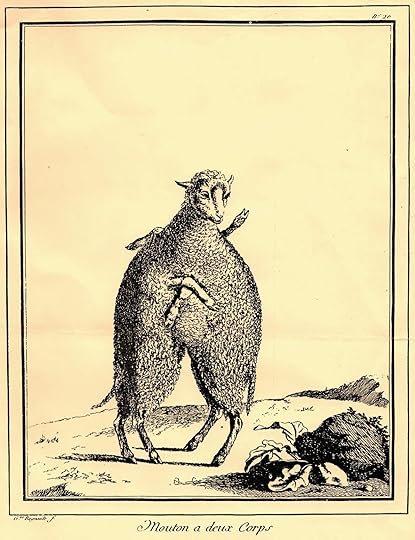 Engraving of a syncephalic lamb displaying incomplete separation of its two bodies
Engraving of a syncephalic lamb displaying incomplete separation of its two bodiesExamples of syncephaly have been recorded from many different animal species, including our own Homo sapiens. However, because of internal anatomical complications, not to mention the physiological strain of a single head attempting to maintain full neurological control and metabolic functioning of two bodies, syncephalic individuals possessing totally discrete bodies rarely survive for very long following birth. (In contrast, bicephalic or dicephalous individuals, possessing a single body but two heads, do sometimes survive to maturity, especially in certain creatures such as terrapins and snakes – click here for more information concerning two-headed snakes.)
Consequently, the concept of a surviving syncephalic lamb that possessed not just two but three completely separated bodies seemed too surreal, let alone too implausible, to warrant even the most cursory of considerations. So I simply filed away the engraving in one of my folders of teratological material and forgot all about it – until last Friday, 6 February 2015. For that was when I paid a visit to a very special attraction and saw something there that totally challenged my previous assumptions concerning syncephalic animals and their likelihood of surviving for any notable length of time following birth – and, in turn, made me think again about that anomalous triplicate lamb from Hungary.
 Robert Ripley, founder of the Ripley's Believe It Or Not! franchise (public domain/Wikipedia)
Robert Ripley, founder of the Ripley's Believe It Or Not! franchise (public domain/Wikipedia)The attraction in question was Ripley's Believe It Or Not! Odditorium London (click here to visit its official website). Situated on the corner of London's Piccadilly Circus, this is a spectacular six-storey exhibition centre that is packed throughout with bizarre curiosities and interactive displays celebrating the famous books, TV shows, and newspaper strips documenting all manner of incredibly weird yet wonderful people, animals, buildings, creations, and much much more that were originally compiled, collected, and drawn by entrepreneur-cartoonist Robert Ripley (1890-1949) for his countless publications.
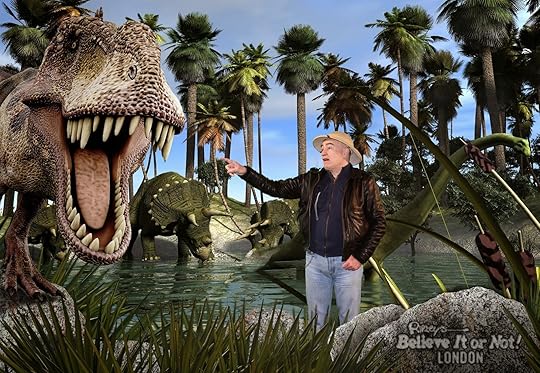 Experiencing some Mesozoic mayhem at Ripley's Believe It Or Not! Odditorium London (© Dr Karl Shuker)
Experiencing some Mesozoic mayhem at Ripley's Believe It Or Not! Odditorium London (© Dr Karl Shuker)As a zoologist, it was obviously the various –and extremely varied – animal attractions that particularly interested me, and I was certainly not disappointed in the array on display. There are many Ripley's Believe It Or Not! Odditoriums worldwide, especially in the USA (but with London's being the largest one of all), and they have become synonymous with teratological animals. There was certainly a goodly selection here in London (some of which were actual taxiderm specimens, others models of real specimens), including several two-headed creatures, animals with extra (supernumerary) limbs (a condition known as polymelia), and other equally curious caprices.
One such creature was a rooster with three separate legs that had been found in 1998 in England (exact location not specified), and was on display alongside a five-legged lamb (its right hind limb was a double leg), again from England and found during the early 1990s.
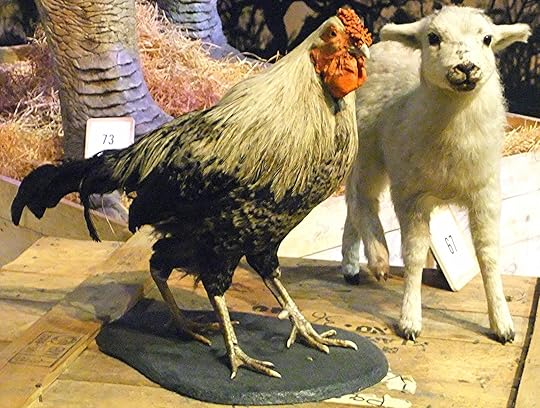 A three-legged rooster and a five-legged lamb – two polymelic animals at Ripley's Believe It Or Not! Odditorium London (© Dr Karl Shuker)
A three-legged rooster and a five-legged lamb – two polymelic animals at Ripley's Believe It Or Not! Odditorium London (© Dr Karl Shuker)The two-headed lamb standing close by had been born in Shandong, China, in 2006, and both of its heads were fully functioning, with separate personalities.
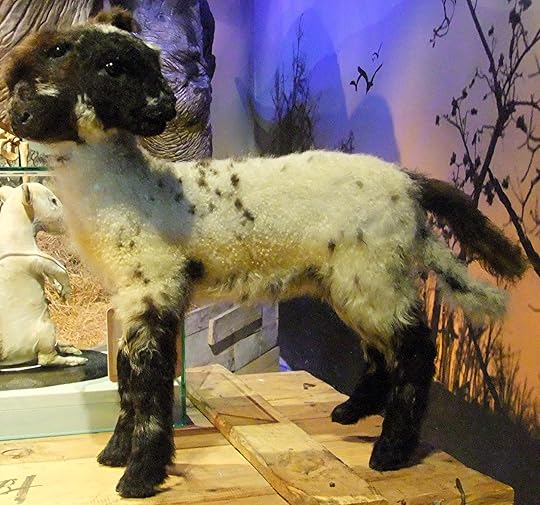 Ripley's two-headed lamb from Shandong, China (© Dr Karl Shuker)
Ripley's two-headed lamb from Shandong, China (© Dr Karl Shuker)Just behind it was a pair of conjoined ('Siamese') piglets, joined back-to-back but with separate necks and heads (thus constituting a lesser version of the controversial rachipagus condition, in which conjoined twins are joined dorsally from the back of their heads down the entire length of their backs). These conjoined piglet twins were apparently similar in form to a pair possessed by the eminent Russian tsar Peter the Great (1672-1725), who famously owned a sizeable collection of scientific curiosities (click here for more information concerning this).
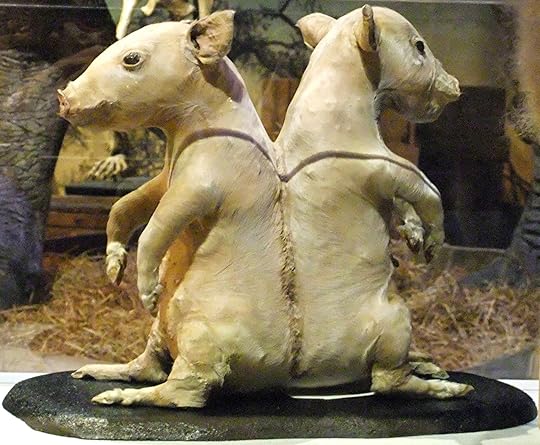 The conjoined piglets at Ripley's Believe It Or Not! Odditorium London (© Dr Karl Shuker)
The conjoined piglets at Ripley's Believe It Or Not! Odditorium London (© Dr Karl Shuker)Just inside the entrance to the odditorium was a taxiderm specimen of an adult black-and-white Friesian cow, which looked totally normal – until I realised that a fully-formed fifth leg complete with hoofed foot was growing outwards and upwards from between its shoulders! This bizarre teratological condition is called notomelia, and indicates that during this cow's embryogeny a supernumerary, aberrantly-located limb bud had developed. Alternatively, but more dramatically, as an example of what could be termed pseudonotomelia it is possible that the cow had originated as a pair of twins but that one of these two twins had subsequently degenerated and had been almost totally reabsorbed into the other one during their embryonic development, with only the single limb providing external evidence of the absorbed twin's former existence as a separate entity. (A very similar instance of notomelia, featuring a male Friesian calf, was published in the July 2014 issue of the Canadian Veterinary Journal.)
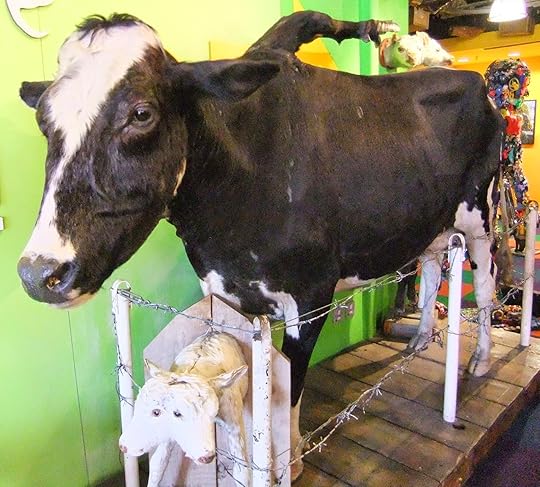 Ripley's notomelic Friesian cow possessing a dorsally-sited supernumerary leg, plus the heads and forequarters of a small white two-headed calf (© Dr Karl Shuker)
Ripley's notomelic Friesian cow possessing a dorsally-sited supernumerary leg, plus the heads and forequarters of a small white two-headed calf (© Dr Karl Shuker)Here's another two-headed calf that was on display:
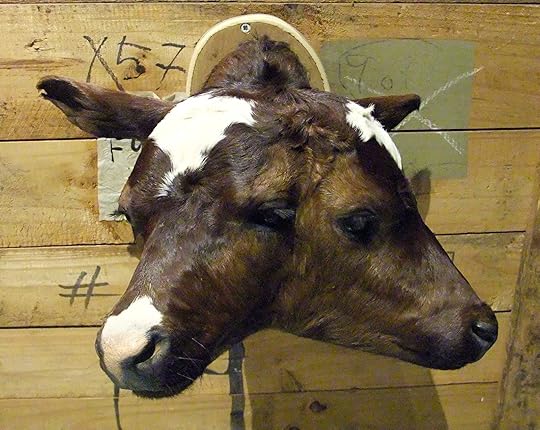 Two-headed calf at Ripley's Believe It Or Not! Odditorium London (© Dr Karl Shuker)
Two-headed calf at Ripley's Believe It Or Not! Odditorium London (© Dr Karl Shuker)And here's an albino alligator, complete with ruby-red eyes:
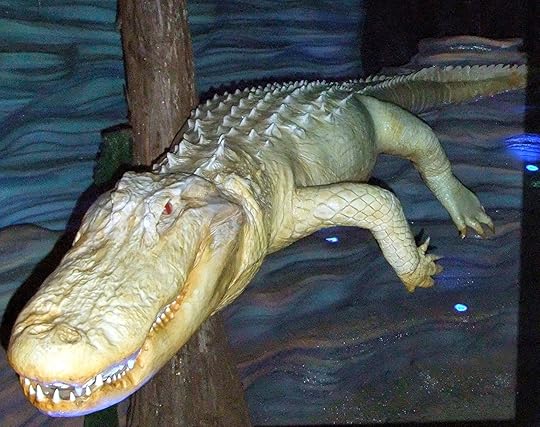 Albino alligator at Ripley's Believe It Or Not! Odditorium London (© Dr Karl Shuker)
Albino alligator at Ripley's Believe It Or Not! Odditorium London (© Dr Karl Shuker)There were also a number of life-sized models of famous human curiosities. At one extreme was a model of Alypius, a dwarf from Alexandria during ancient Egyptian times, who was only 43 cm (17 in) tall, and whose fitting punishment for committing treason was imprisonment inside a parrot cage!
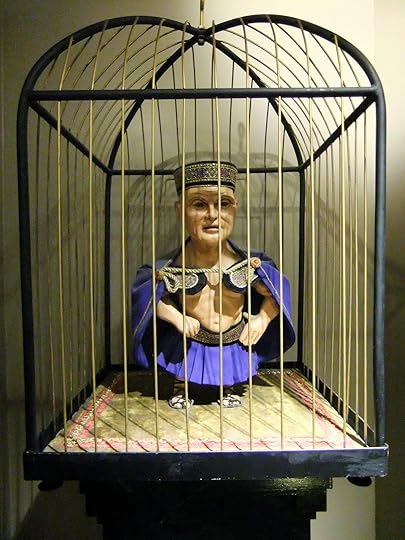 Model of Alypius at Ripley's Believe It Or Not! Odditorium London (© Dr Karl Shuker)
Model of Alypius at Ripley's Believe It Or Not! Odditorium London (© Dr Karl Shuker)And at the other extreme, standing in front of a full-sized American mastodon skeleton that only served to emphasise his truly exceptional stature, was a full-sized model of Robert Wadlow (1918-1940), immortalised in the record books as the world's tallest man. Suffering from pituitary-induced gigantism, when he died aged just 22 years old he was already a little over 8 ft 11 in tall, and was still growing. Indeed, had he grown just under one inch more, he would have been the only confirmed 9-ft-tall human ever recorded. Standing alongside this real-life giant's model, even at a respectable 5 ft 10 in tall I still felt totally overshadowed by him, and overawed too.
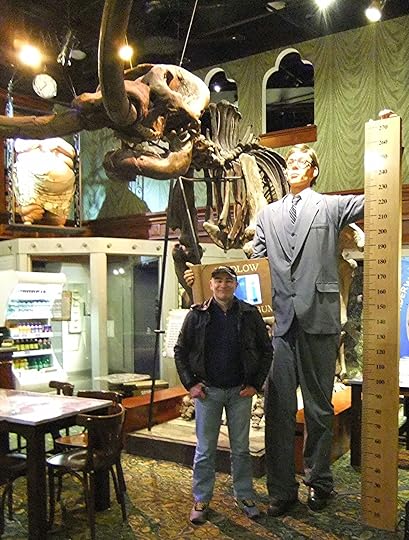 Standing alongside the life-sized model of Robert Wadlow at Ripley's Believe It Or Not! Odditorium London (© Dr Karl Shuker)
Standing alongside the life-sized model of Robert Wadlow at Ripley's Believe It Or Not! Odditorium London (© Dr Karl Shuker)Equally eyecatching was a full-sized bust of a man exhibiting hypertrichosis, also known as werewolf syndrome as persons displaying this condition of extreme hairiness were once believed by the superstitious to be lycanthropes.
 Bust of a man exhibiting hypertrichosis at Ripley's Believe It Or Not! Odditorium London (© Dr Karl Shuker)
Bust of a man exhibiting hypertrichosis at Ripley's Believe It Or Not! Odditorium London (© Dr Karl Shuker)Also well worthy of attention was the conical, elongated skull of an ancient Peruvian, its extreme shape having resulted from the practice prevalent then and there of using tightly-wrapped cloth, boards, and rope to distort the shape of a child's growing skull via rigorous binding.
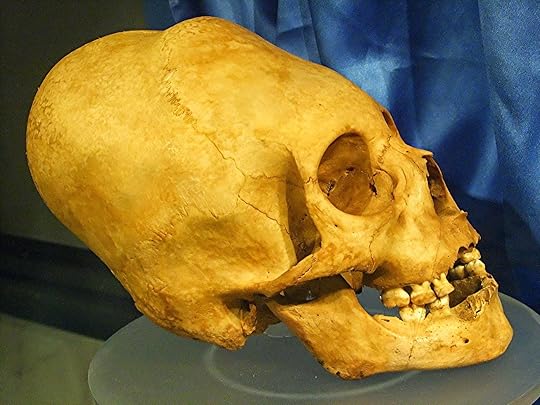 Manually-distorted conical skull of an ancient Peruvian at Ripley's Believe It Or Not! Odditorium London (© Dr Karl Shuker)
Manually-distorted conical skull of an ancient Peruvian at Ripley's Believe It Or Not! Odditorium London (© Dr Karl Shuker)Yet despite all of these wonders and marvels, the specimen that startled me most at Ripley's Believe It Or Not Odditorium London was not actually on physical display there. Instead, it appeared – and even then only very fleetingly – on a video being played in loop format on a screen close to most of the teratological animal specimens. The video showed a selection of teratological animals that were on display at various odditoriums around the world, and also included some footage of certain of these animals when they were still alive. Watching this video, I was astonished when a couple of seconds of film was shown of a living, seemingly adult, and clearly perfectly healthy syncephalic donkey, which consisted of a single head to which were connected two completely separated, fully-formed bodies!
By the time that my mind had registered this astonishing image, the video had moved on to showing other specimens, so I waited until it looped back to the beginning and then looked out for the donkey footage. After studying it intently when it reappeared, there was no doubt in my mind about what I had seen. It was indeed as I'd thought it to be on fist viewing, both in form and in condition, though even now I struggle to comprehend how such a creature could survive to maturity – two independent four-legged bodies linked to a single controlling head.
After then waiting for the footage to come round a third time, when it did so I snapped a photo of this amazing donkey-in-duplicate, which although of poor quality would serve as a visual record of it for my files, and I vowed to investigate the matter further when I returned home. After all, if such a creature could truly exist and survive to adulthood, even the ostensibly impossible triplicate-bodied syncephalic lamb of Hungary suddenly seemed less implausible.
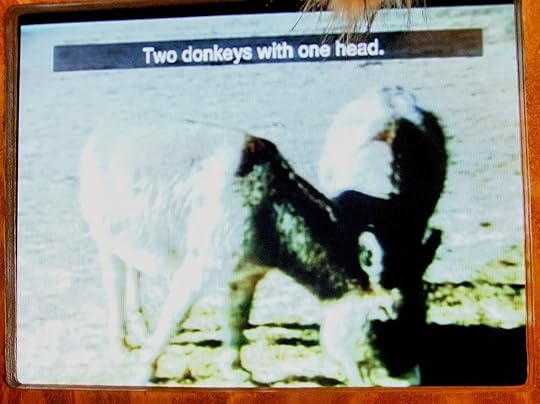 My photographic record of the syncephalic donkey as featured in the video shown at Ripley's Believe It or Not! Odditorium London (© Dr Karl Shuker/Ripley's Believe It or Not! Odditorium London)
My photographic record of the syncephalic donkey as featured in the video shown at Ripley's Believe It or Not! Odditorium London (© Dr Karl Shuker/Ripley's Believe It or Not! Odditorium London)And sure enough, my online researches have indeed confirmed the donkey's reality. Named Rascal, he was a miniature donkey owned by farmer Paul Springer whose farm is situated near Mineral Point, Wisconsin, USA. Paul's longstanding interest in teratological livestock has led him over the years to purchase a number of specimens that exhibit some anatomical peculiarity but are otherwise healthy and not suffering in any way, and allow them to live out a full, happy life on his farm instead of being slaughtered by their original owners either for their meat or simply because they were different.
Paul's first purchase was a six-legged calf called Boldegard during the 1970s, who went on to enjoy a long 14-year life on Paul's farm, followed by a range of other animals with extra legs, additional horns, two heads, or, in Rascal's case, one head and two bodies. Following their eventual deaths, half a dozen of the most striking individuals have been sold by Paul to the Ripley's Believe It Or Not! franchise for exhibition in various of their odditoriums. So it is possible that Rascal is on display in one of them, somewhere in the world. Consequently, if any of my readers have seen him, and can send me details, I'd very much like to receive them here – many thanks indeed in advance!
How uplifting it is to read of Paul Springer's compassion for all of the out-of-the-ordinary creatures that he has rescued from certain premature death. When asked in a media interview (WSAW.com 15 November 2009) what compelled him to rescue and care for animals with abnormalities, his answer was as inspirational as it was direct:
"There's something about them that maybe I feel sorry for. I give them a life. Most people will put them down and sell them. I am proud of them. People who see them, it gives them a chance to realize that everything isn't [normal], whether it be human beings or pigs or people or cats or dogs, we're not all born normal. Just because somebody has a handicap, they shouldn't be shunned. They should be given every chance, and love and attention that's possible."
Amen to that!
 Rascal when alive (© Paul Springer)
Rascal when alive (© Paul Springer)
Published on February 10, 2015 11:06
Karl Shuker's Blog
- Karl Shuker's profile
- 45 followers
Karl Shuker isn't a Goodreads Author
(yet),
but they
do have a blog,
so here are some recent posts imported from
their feed.



